#ways i’m imagining this: like historical chinese fashion
Text
for good omens s3 i hope we get to see crowley with REALLY long hair, waist length or longer. just luxurious long locks pooling around him
#ways i’m imagining this: like historical chinese fashion#ways this is more likely: those stupid 1600s curly wigs#anyway#not to be biased but i like long haired crowley#good omens#mine#not that i Want them to do asian history because i think that might just turn out bad#but i think all those chinese history books my mom made us read as kids rubbed off
313 notes
·
View notes
Text
Reviewing Nancy Duong’s Fashion Timeline of Chinese Clothing
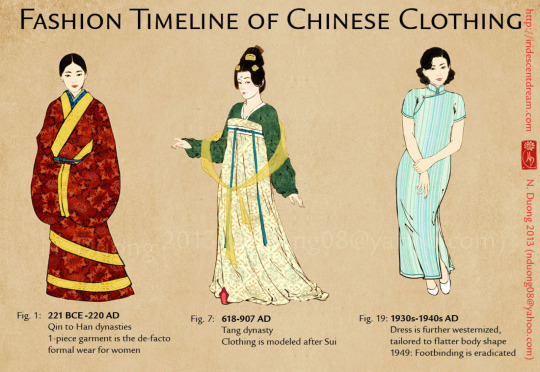
If you like historical Chinese clothing and have an internet connection chances are you have seen these drawings. They have been spread around so much but for some reason I was only able to find out the author yesterday (at time of writing), Nancy Duong from @nannaia. Her website is nancyduong.com. These drawings are so iconic and famous but I don’t really see anybody talking about their accuracy? So I thought it’d be fun to review the drawings as well as the sources used. Ok clickbaity title here, I’m only going to talk about the segments on Ming, Qing and republican era because I know nothing about the others.
Quick disclaimer: none of what I am going to say is a criticism of the artist or her research abilities, as we will see Duong obviously put a lot of efforts into the research and this project was absolutely epic; this will just be a nitpicky review of some of the details which I hope some of you will find useful or enlightening. Also the fact that this was made in 2013 still blows my mind, like I was still a wee child then.
Without further ado, let’s get into it.
Ming Dynasty (1368-1644)
*I’m not yet so familiar with the minutiae of Ming fashion so if anything I say is whack feel free to correct me.

I’ll begin with Fig 12 which is the beginning of the Ming Dynasty. This doesn’t really look like what we think of as early Ming fashion nowadays because I think the reference material she used was likely a 仕女画 shinvhua, a genre of literati painting that featured highly stylized female figures in historicist clothing. The costumes were meant to be excessively flowing and adhering to people’s imaginations of deities or historical figures, meaning that they had little to no connection to what was actually popular in real life. This is a very common misunderstanding for earlier scholars of Chinese fashion history, they just weren’t aware that 仕女画 were not realistic. In her post, Duong mentioned that one of the books she consulted was 5000 Years of Chinese Costume published in 1987, which is very dated and kind of notorious for using a lot of non realistic art as reference for real fashion... In recent years there has been more awareness about what paintings could be used for research and what could not, but in 2013 that was probably too much to ask. So this is more of a sign of the times.

Source here
Ming Dynasty shinvhua by 仇英 Qiu Ying (1492-1552), a renowned painter. For some reason the costumes in most shinvhua feature an apron of some kind tied to the waist and a 披帛 pibo or shawl, perhaps it was a reference to Tang Dynasty fashion. If you see a painting from the Ming Dynasty or later featuring women wearing an apron and a shawl, it’s a huge red flag that the clothing is not realistic. From the Ming Dynasty onward, women wore robes outside of skirts, meaning the waistband shouldn’t really be visible.

Source here
Closeup of 真武灵应图册, presumably made in the early 15th century, showing the more realistic way of dressing for women in the early Ming.
The other thing here is the caption “restoration of native rule, Yuan customs are abolished”. While that is true on paper, in practice early Ming fashion was full of leftovers from the Yuan Dynasty. A popular decoration style was 织金锦 zhijinjin or gold brocade, a textile manufacturing technique presumably of Persian origin that was immensely popular among the Mongols. I can understand why the first emperor of the Ming would advertise himself as the restorer of Han customs for legitimacy and power, but personally he was a huge fan of gold brocade too ;)
Ok next panel.
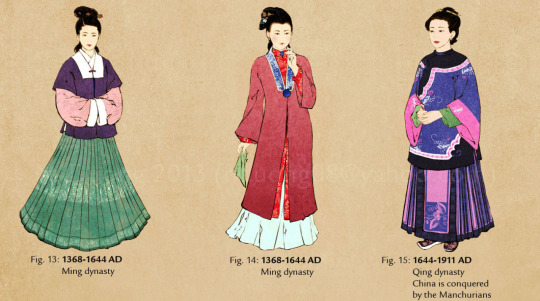
Fig 13 is probably traced from this painting below, which is very legit. The only minor qualm is that Duong seems to have added two 裙襕 qunlan or decorative horizontal strips to the skirt, which are not present in the painting itself. This style of qunlan was common in the early Ming (you can see it in the previous painting) but I’m not sure if it would be acceptable on this particular outfit.

Source here
Next one.

Fig 14 is where it gets interesting and where my niche area of expertise comes in. Duong didn’t specify which part of the Ming Dynasty each outfit was from, but there is at least a 200 year gap between fig 13 and 14, because fig 14 is from the Qing Dynasty... I mentioned this in my review of Evolution & Revolution, I’ll just repeat here. A lot of early historians bought into the rhetoric that the “late Ming aesthetic” continued into the Qing for a couple of years before being obliterated by a mystical form of Manchu inspired dress (something that looks like fig 15 probably). In reality though, that so called “late Ming aesthetic” persisted well into the 18th century until the Jiaqing era when it began to be replaced by a new style, which also wasn’t the stereotypical Qing Dynasty outfit; that didn’t solidify into a thing until the 1840s, at which point the Qing was seven decades away from death. Because of this, fashion from the 18th century often gets mislabeled as Ming. It could be potentially considered hanfu but it’s definitely not Ming... I feel like 17th and 18th century clothing represent the Qing as much as the 19th century does, the Qing is not just the 19th century.
Fig 14 specifically reads very much as Yongzheng era (1720s), with the back heavy hairstyle, tight fitting 披风 pifeng, robe with standing collar and the white skirt. This confusion really isn’t Duong’s fault but more of the book’s. If I analyzed this as Yongzheng era fashion, it would be pretty accurate with the only problems being the sleeve length and button placement. The sleeves are way too short for that era. Before 挽袖 wanxiu or folded cuffs became a thing in the Qianlong era, the sleeves of most Chinese historical clothing were made longer than the wearer’s arms, meaning they had to grab the cuffs to use their hands, creating very beautiful folds and creases when doing that. Also the sleeves commonly had a decorative border similar to that at the collar. The lower button was usually placed at the very bottom of the collar because that would actually connect the collar and the neck area. You see what I mean in the below image.

Source here
A painting from the series 雍亲王十二美人图, made in the 1710s/20s. These paintings are full of mysteries and we aren’t even sure who the women (or woman) portrayed really were, but they did depict Han aristocratic women’s fashion realistically. Some of the details resemble late Ming fashion, such as the metal buttons, soft standing collar and parallel collar pifeng, but this is undeniably Qing.

Source here
I think this illustration is from 5000 Years? It’s categorized as Ming Dynasty in the book which is what led a lot of people astray.
By the way, this hairstyle that looks like poop, is from the Yongzheng era as well.
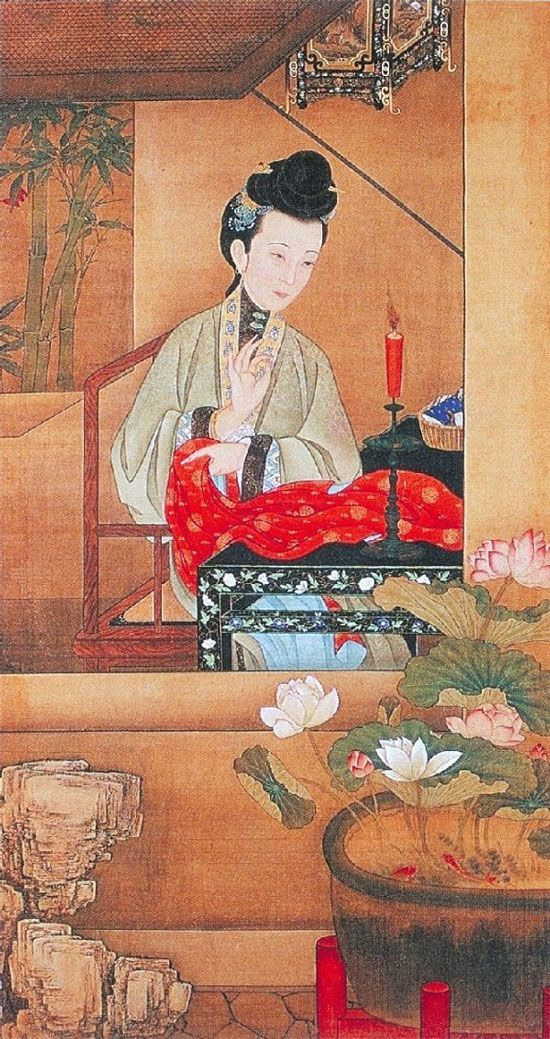
Source here
Also from 雍亲王十二美人图.
Now I can’t just tell you what Ming fashion is not and not tell you what it is. Duong actually neglected huge chunks of the Ming Dynasty in the infographics, like fig 13 is 14something and fig 14 is 1720s. The 16th and 17th centuries are completely missing, which is a shame because they were very beautiful. @ziseviolet has a Ming Dynasty tag with plenty of images, I don’t have a lot of primary images for the Ming so please just enjoy these two:
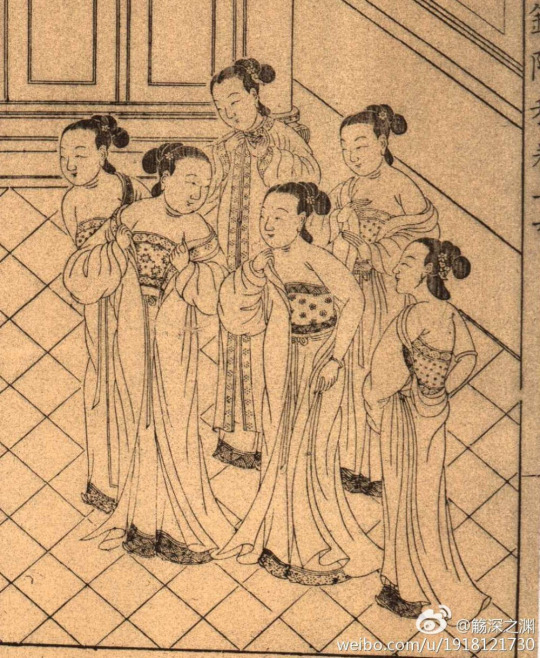
Source here or see watermark
A very particular look from the Wanli era (1572-1620).

Source here
Late Ming, possibly Chongzhen era (1627-44) illustration showing the fad for big sleeves.
Now that I have the drawings out of the way, let’s take a look at Duong’s notes on her research:
“The clothing for women in the Ming Dynasty consisted mainly of gowns, coats, rosy capes, over-dresses with or without sleeves, and skirts. These styles were imitations of ones first seen in the Tang and Song Dynasties. However, the openings were on the right-hand side, according to the Han Dynasty convention.” ((5,000 years of Chinese Costume, pg. 147)
I don’t have this book with me but I think this was pulled from early Ming Dynasty regulations on dress. This is kind of vague; I think the more precise term used in 2021 would be 袄裙 aoqun or robe and skirt, to describe the most common combination worn in the early Ming. “Rosy capes” sounds like a literal translation of 霞帔 xiapei, which was a garment reserved for formal dress and weddings. I don’t think your average woman would roam about the street in a xiapei. The part about the source of inspiration being the Tang and Song is also true on paper, but visually the early Ming was a very different style to the Tang and Song.
Also the thing with the openings on the right hand side. Theoretically everybody in the Ming should wear the openings on the right but in the early and mid Ming because of Yuan customs carrying over, many women still wore robes with closures on the left. It gradually began to be phased out by the mid Ming but was still occasionally practiced well into the Qing and 20th century.
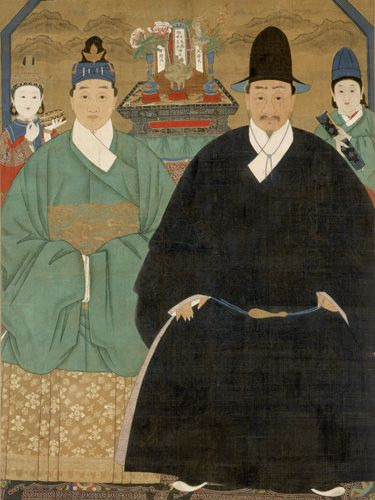
Source here
A Ming portrait featuring a woman in a robe with left closures. I don’t know which decade this is from because I suck at dating Ming clothing uwu I’m opening up about my weaknesses.
“The formal dress for commoners could only be made of coarse purple cloth, and no gold embroidery was allowed. Gowns could only in such light colours as purple, green and pink; and in no case should crimson, reddish blue or yellow be used. These regulations were observed for over a decade, and it was not until the 14th year of Hong Wu that minor changes were made.” (5,000 years of Chinese Costume, pg. 147)
Is this turning into a review of 5000 Years of Chinese Costume... Whatever. Again this is also likely pulled from sumptuary laws which people had completely stopped observing in the mid to late Ming. For the early Ming this does hold true though.
Qing Dynasty (1644-1911)

Not to be rude or anything but wow I didn’t know the Qing Dynasty began in the 1860s. I mean, fig 15 is legitimate Qing fashion and drawn very well but the fact that it’s placed at the beginning coupled with the caption “China is conquered by the Manchurians” suggests that this is what Qing Han fashion looked like since the beginning, which is not true. This look only came into its own in the Daoguang era (1820-50), 180 years after the establishment of the Qing Dynasty. Also the lady is shown with natural feet but foot binding was supposedly at the peek of its popularity in the mid 19th century; although a lot of women didn’t bind, it’d be a more accurate representation of the fashion ideal if bound feet were drawn.

Source here
Export art from the Daoguang era (1820-50). This is earlier than fig 15 hence the higher collar and simplistic fabric.
Next panel.

Fig 16 looks 1880s, which is great in that it shows the progression of time since fig 15. I love that it shows aoku, which was the more popular combination in the late 19th century. The round hair ornament is there (though the tassels are somewhat unnecessary). The bound feet are there. The robe even has the split front trim design, a very nice period detail. The collar is a bit weird though like 1) it should be much lower 2) it should be able to close completely; this kind of collar gap did not become a fashionable thing until the 1900s, but even then the bottom would still be closed because it was made by simply not buttoning the collar not a deliberately designed gap. The sleeves are also too short for the 1880s. Even then this is a well done drawing.
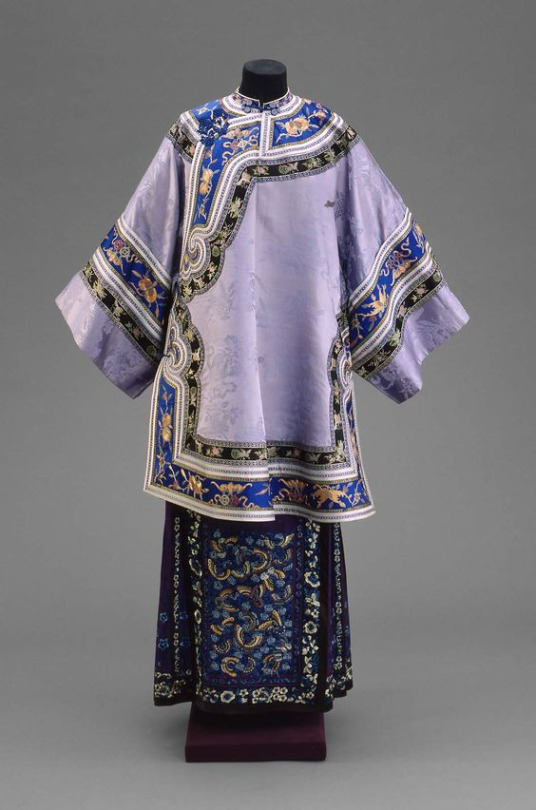
Source here
Aoqun ensemble from the 1870s or 80s. The robe has the split front trim like in fig 16, while the skirt is more like that shown in fig 15 with the rectangular area of embroidery and trimmed pleats.

Source here
The lady on the left is wearing aoku ca. 1885.
My bone with this one is again mainly the caption “The Manchurians attempt several bans on foot-binding but are unsuccessful”. It refers to events at the very very beginning of the Qing, which appears somewhat anachronistic when placed under a drawing of the 1880s... As the Qing progressed the emperors increasingly came to the realization that Han women’s fashion was too powerful to be regulated and just gave up on banning foot binding :0
Although it’s probably not fair to judge this series for what it did not include, I still think it’s really sad that there are only two drawings for the Qing and both of them from the 19th century... I’ll photobomb you with early to mid Qing fashion.

Source here
Kangxi era (1661-1722) painting.
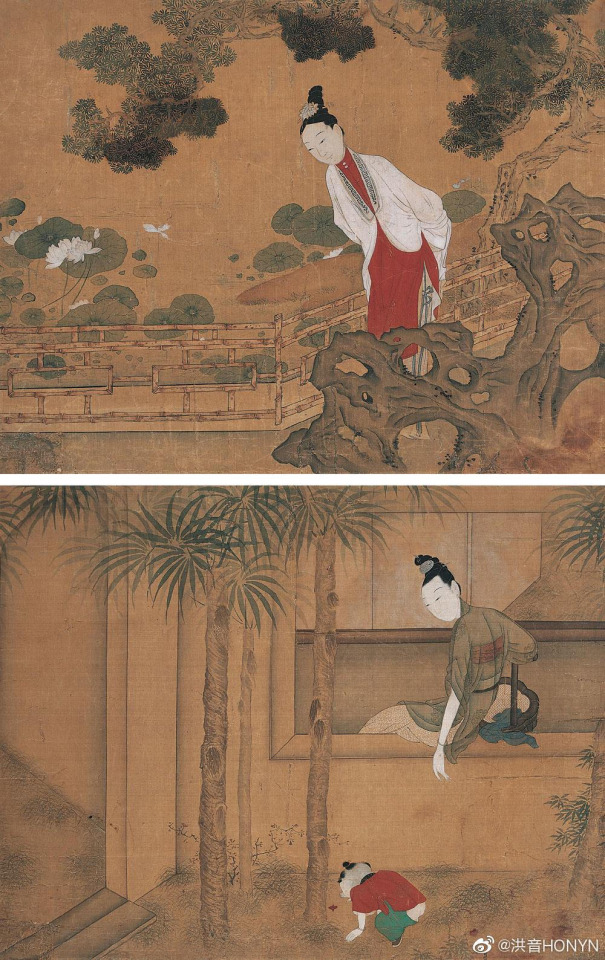
Source here or see watermark
Early Qianlong era (1730s or 40s) painting.

Source here
Mid to late Qianlong era (1750s-90s) reverse glass painting.

Source here
Jiaqing era (1796-1820) wallpaper.

Source here
Daoguang era (1820-50) reverse glass painting.
After fig 15 there should still be two looks, the 1890s and 1900s, for which I have an individual post.

Source here
1890s or 1900s aoku. I think this is from the Hong Kong Museum of History?
Now onto the writings:
When China fell under Manchurian rule, Chinese men were forced to adopt Manchurian customs. As a sign of submission, the new government made a decree that men must shave their head and wear the Manchurian queue or lose their heads. Many choose the latter.
Legit, nothing to see here. Maybe the phrasing of the last part is overly dramatic, since the majority of men opted for the queue and survived.
On the other hand, Chinese women were not pressured to adopt Manchurian clothing and fashions. “Women, in general, wore skirts as their lower garments, and red skirts were for women of position. At first, there were still the “phoenix-tail” skirt and the “moonlight” skirt and others from the Ming tradition. However the styles evolved with the passage of time: some skirts were adorned with ribbons that floated in the air when one walked; some had little bells fastened under them: ...
First sentence completely legit. The red skirt bit is slightly unfounded, the most popular skirts during the Ming-Qing transition were white. “Phoenix-tail” skirt and “moonlight” skirt are probably literal translations of 凤尾裙 fengweiqun and 月华裙 yuehuaqun, neither of which were from the Ming. In fact, I have not yet seen either appear in mainstream fashion before the mid 18th century. Both of these terminologies are kind of vague and to this day I still haven’t found literature giving solid explanations of what they are.
Phoenix tail skirts were likely made by attaching embroidered ribbons of different colors to a waistband. The “ribbons that floated in the air when one walked” and “little bells fastened under them” did not evolve with the passage of time, but were a part of the construction of this garment to begin with. I think they were more of an overskirt meant to be worn over an actual 马面 mamian skirt? Extant examples of phoenix tail skirts from the 18th century existed because they likely took inspiration from theater costumes, notably skirts from the 宫衣 gongyi ensemble worn by royal female characters. I don’t think they became everyday fashion until the mid 18th century, even then they were pretty rare.

Source here
Phoenix tail skirt from the Qing, presumably 19th century.
Moonlight skirts were structurally the same as mamian skirts but every pleat or vertical section was a different color.
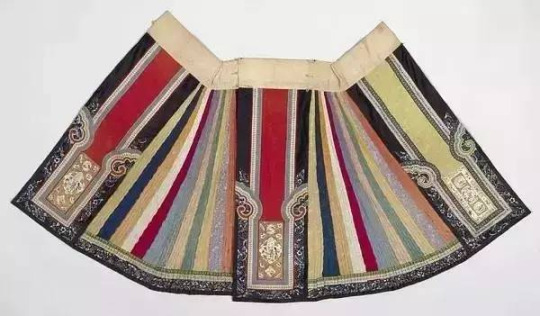
Source here
Moonlight skirt, presumably 19th century.
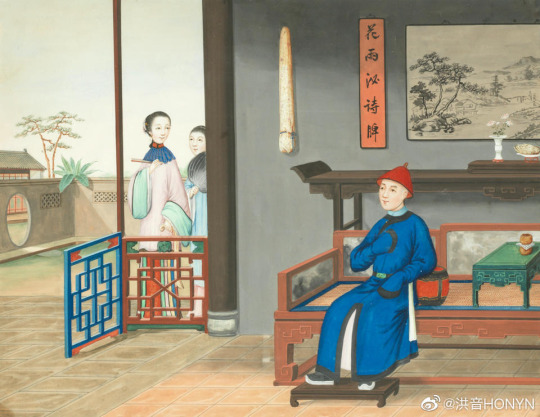
Source here or see watermark
Detail of a Jiaqing era painting showing the lady on the left in a moonlight skirt.
...others had their lower edge embroidered with wavy designs. ...
The “wavy designs” embroidered at the lower edge is somewhat unclear, as it could refer to qunlan used since the early Ming or specifically the wavy shape of the hems in Guangxu era (1875-1908) 花神衣 huashenyi?? It was a type of theater costume and not everyday wear, and also I’ve only seen this wavy design on robes not skirts. If it were actually referring to qunlan or border binding, that has always been used in the Ming and Qing, albeit in different styles in each era.

Source here
Guangxu era huanshenyi costume.
...As the dynasty drew to an end, the wearing of trousers became the fashion among commoner women. There were trousers with full crotches and over trousers, both made of silk embroidered with patters.” (5,000 years of Chinese Costume, pg. 173)
Yess aoku was very popular. It became “fashionable” in the beginning of the 19th century but working women like maids wore them in the 18th century as well.
Republican era (1912-1949)

Ok so republican era fashion was extremely fast changing and convoluted which is why I wrote a whole series on it. If you’re interested in the looks not covered by these drawings do check them out :)) I’m kind of tired of going back and forth and linking all the posts I wrote so if you would like to know more about a specific decade just come back to the masterpost here.
With fig 17 we’re already in the mid 1920s, a decade after the revolution. This is a pretty good drawing, mostly showing the aoqun ensemble correctly. It has the half length flared pagoda sleeves or 倒大袖 daodaxiu, the stiffened collar that closes with one button and the curved robe hem, which are all accurate details. The black mary janes are correct, albeit slightly basic and stereotypical; there were so many cool shoes in the 20s (but hey it’s great that Duong didn’t draw T-straps the arch-nemesis of historically accurate flapper footwear). The hair with the section of bangs is extremely 20s and deserves a medal. There seems to be a low bun at the back of the head, I mean women with long hair did roll up their hair to emulate the short bob but it wouldn’t be so big and rest so low on the head. The skirt is appropriately gathered and flared; however it seems a tad too long for the mid 20s, since most mid 20s skirts were knee or at least calf length. It could also work for 1926-28, but then it would have a more tubular silhouette and the top needs to be shorter and more form fitting.

Source here
Song Qinling and Sun Yat-sen ca. 1926-28. I think this is the vibe Duong was going for? If the skirt were less A-line it would be perfect.
Another (very) minor issue is the lack of binding on the right side of the figure’s neck. It’s very possible that Duong traced this photograph where it isn’t visible because of the shadow, but all Chinese clothing prior to the 1950s had the binding/trim go all around the neck.
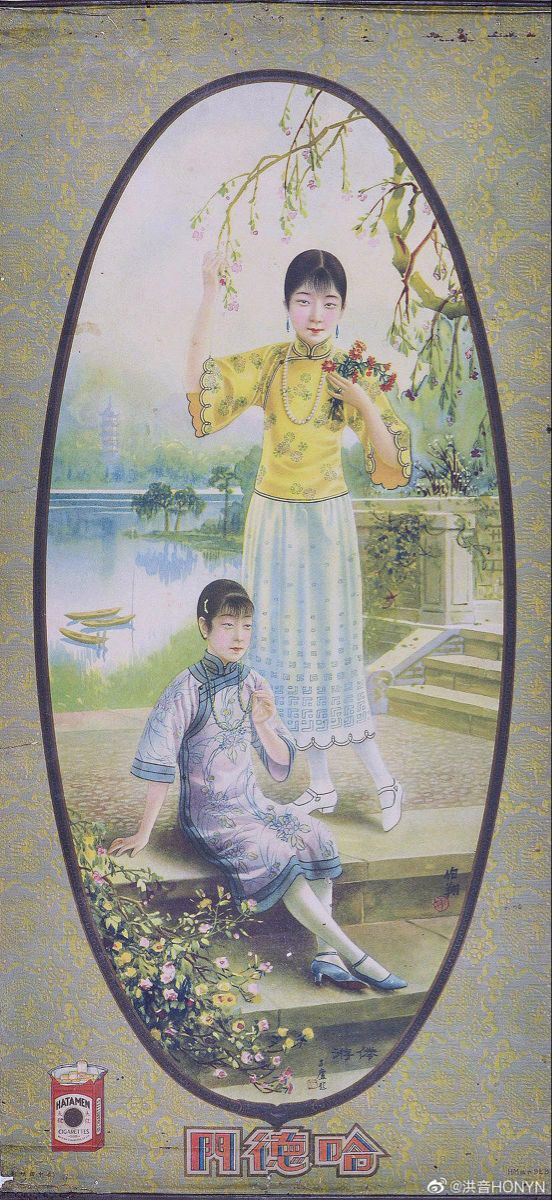
Source here
Painting from around the same time, you can clearly see the trim on the right side of the neck. And look at their gorgeous shoes!
I’ll just quickly address the caption: “1927: Natural Breast Movement; Native attempts on banning foot-binding remain unsuccessful”. The natural breast movement is something people talk about a lot, but aside from their moralistic discourse I’d like to also bring fashion into the perspective. Basically since the Ming Dynasty, Chinese women bound their breasts to flatten them, and in the republican era some people started to think that it was unnatural and unhealthy, so they started to advocate for “natural breasts” in the 1920s. Unfortunately for them, because Chinese women wanted to be more or less on the same page as Western women on fashion and the popular silhouette in 20s Western fashion was also flat chested, Chinese women’s breast curves did not begin to show until around 1933 in high fashion, when breasts were again emphasized in Western high fashion. That’s not to say that individual women did not take off their breast binders, it’s just that the high fashion ideal did not switch to having boobs until the 30s. Changing fashions did what doctors and “progressive” activists couldn’t do for decades, I live for that.
On my usual feminist tangent here, I really don’t like the idea that “natural breasts” is interchangeable with “curvy”? Some women naturally have the flat 1920s silhouette and it’s not like their bodies are invalid. If you want to say normalize curves just say normalize curves, wearing bras and having big boobs are not inherently “natural”...
Still this one is pretty good, next one.

Fig 18 is the cheongsam rendition of the same silhouette as fig 17. In the late 1920s, four styles of womenswear with the same silhouette coexisted, namely 1) the two piece aoqun shown in fig 17, 2) three piece aoqun with vest, 3) long vest with sleeves derived from 2 and 4) the one piece cheongsam derived from 3. The caption is that age old myth about cheongsam being Manchu we can just throw that in the trash. I don’t blame Duong for this at all this myth is extremely widespread. While the cheongsam visually resembles Manchu changyi from the 19th century, it did not evolve from that. Manchu women didn’t give a shit about cheongsam and never wore it either, cheongsam and changyi or chenyi belonged in two very different systems of dress that evolved independently from each other at the time. Also, foot binding became very obsolete among urban “fashionable” women in the 1910s already. It was a very regional practice so it was still done by some women in rural areas or whatnot well into the 20th century, but the high fashion ideal has long switched to natural feet.
The drawing itself is very accurate though, it’s a standard late 20s cheongsam. The hair looks ok as well. The binding is all around the neck this time which is very good. The collar could be slightly higher, especially if approaching the end of the 20s.

Source here
Late 20s cheongsam.
Just gonna quickly show you the 20s three pieces aoqun and vest with sleeves looks not included here.

Source here
Left: three piece aoqun. Right: vest with sleeves.
Moving on to the next panel :3
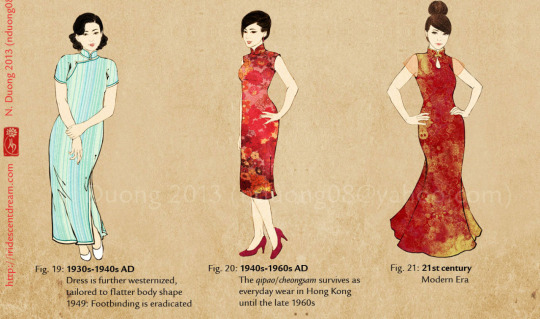
With fig 19 we arrive in the 1930s. With the slightly lower height of the collar and low slits it appears more like the second half of the 30s, maybe 1938-1940ish. This drawing is overall pretty solid. The cap sleeves are there. The binding is in the right places. The shoe shape is appropriate. The rounded edge collar with two buttons is legit. The brush out curls are great.

Source here
Annay May Wong in a late 30s cheongsam.
One minor issue it that due to the T shape in which the cheongsam was cut, the pattern at the sleeve part would run horizontally instead of vertically when the arms are down.

Source here
This is what I mean. This image of Xu Lai is from the early 30s.
Let’s look at the caption: “Dress is further westernized, tailored to flatter body shape. 1949: foot-binding is eradicated”. I guuueeesss you could call the 1930s cheongsam westernized in the sense that it was inspired by the Western evening dress silhouette in that it was long, flowy and slender, but that is not to be confused with “using Western tailoring techniques”. 1930s cheongsam were made completely using the Chinese dressmaking method (平裁 pingcai or flat tailoring). Also “tailored to flatter body shape” is somewhat of a generic and reductive statement, since clothes could show the body shape in a variety of ways using optical illusion and different cuts. The 30s cheongsam was not extremely form fitting to the point that it required negative ease by way of corsets or girdles, it just hugged the body very softly but still left plenty of wiggle space.
I wouldn’t really say that foot binding was “eradicated” anytime anywhere because it was a continuous process not an on or off one, as explained in Dorothy Ko’s Cinderella’s Sisters. Parents stopped binding their daughters after the republican era that’s true, but many older women who had bound in their childhood and found bound feet more comfortable than let out feet continued binding for their own convenience.
Now onto the textual explanation by Duong.
“Ever since the Tang Dynasty, the design of Chinese women’s costumes had kept to the same straight style: flat and straight lines for the chest, shoulders and hips, with few curves visible; and it was not until the 1920’s that Chinese women came to appreciate ‘the beauty of curves’, and to pay attention to figure when cutting and making up dresses, instead of adhering to the traditional style.” (5,000 years of Chinese Costume, pg. 214)
This gives me a stroke. This book is true vintage from the 80s and it never ceases to (negatively) surprise me with incorrect takes. The “straight style” was very much not a thing in the Ming, the authors would know if they looked at the right sources lmao. Curves, what curves in the 1920s? Did you see any curves in the pictures I included of the 1920s? The 1920s flapper silhouette was notoriously flat, unless the flared pagoda sleeves count as curves, in which case most of the Ming and Qing would also be curvy. This is an erroneous stereotype. If you mean “curves” as in showing the shape of the body, in my opinion the 1910s showed a lot more body than the 1920s did. If you mean it as in “curvy” or “hourglass”, then the 1930s was the beginning. If you mean “extreme hourglass”, then the 1950s would be the beginning. More on the 50s later.

Source here
Ca. 1915 fashion, note how tight the robe and pants are.

Source here
1920s aoku, noticeably more relaxed. Still very much flat though.
“The most popular item of a Chinese woman’s wardrobe in modern times was the qi pao. Originall the dress of the Manchus, it was adopted by Han women in the 1920s. Modifications and improvements were then made so that for a time, it became the most fashionable form of dress for women in China.
Already addressed the origin issue: cheongsam was not Manchu. Also aoqun and aoku representation matters.
Two main factors account for women’s general preference for the qi pao: first, it was economical and convenient to wear.” (5,000 years of Chinese Costume, pg. 214-215)
That’s... not true. It was slender and consumed less fabric than older clothing styles so it was more economical for women who were middle class or upward, but the tight, long skirt made it difficult for working women to wear. The cheongsam was largely a phenomenon for privileged women, working women adored the aoku and continued wearing it to the present day. I don’t understand why class issues are seldom addressed in cheongsam discourse.
Women traditionally bound their breasts in the Ming and Qing dynasties with tight fitting vests and continued to do so in the early 20th century.
“The vests were called xiaomajia ‘little vest’ or xiaoshan ‘little shirt” “used by Chinese women as underclothing for the upper part of the body.” (Changing Clothes in China: Fashion, History, Nation: Finnane pg 162) “Doudu [is] a sort of apron for the upper body […] in former times the doudu had been worn by everyone, old and young, male and female. The young wore red, the middle-aged wore white or grey-green, the elderly wore black. A little pocket sewn into the top was used by adults to secrete them money and by children their sweets. When a girl got engaged, she would show off her embroidery skills by sending an elaborately worked doudu to her fiancé, decorated with bats for good forturne and pomegranates, symbolizing many sons.” (Changing Clothes in China: Fashion, History, Nation: Finnane pg 162)
This part is incredibly legit, mostly because Duong cited more reliable sources. Thank you for releasing me from the hell that is 5000 Years.
A ban on bound breasts began in 1927, in which the government started advocating for the “Natural Breast Movement”. Despite this, bound breasts still widely continued into the 1930s. The government also banned earrings as it fell under the criteria of deforming the natural body. The 1930s also saw the introduction of the western/French bra come to Shanghai.
Ok I didn’t even know about the ban on bound breasts, most fashionable women had quite flat breasts up until 1933. The earrings ban too, like earrings seemed very popular throughout the republican era.
“The little vest was designed to constrain the breasts and streamline the body. Such a garment was necessary to look comme il faut around 1908, when (as J. Dyer Ball observed): ‘fashion decreed that jackets should fit tight, though not yielding to the contours of the figure, except in the slightest degree, as such an exposure of the body would be considered immodest.’ It became necessary again in the mid-twenties, when the jacket-blouse—a garment cut on rounded lines – began to give way to the qipao. At this stage, darts were not used to tailor the bodice or upper part of the qipao, nor would they be till the mid-fifties. The most that could be done by way of further fitting the qipao to the bosom was to stretch the material at the right places through ironing. Under these circumstances, breast-binding must have made the tailor’s task easier.” (Finnane 163, Changing Clothes in China: Fashion, History, Nation)
Woww this part is actually really good I’m impressed! Yess the little vest was worn to alter a woman’s body to fit the fashionable flat silhouette. I love how Finnane acknowledged that darts were not used on cheongsam until the 50s and shaping could only be achieved by 归拔 guiba, stretching the fabric and ironing the shit out of it. I’ll explain it in more details when I post about making a 30s cheongsam (still waiting for the pankou currently 😠).
Successful eradication of bound feet would not come until the 1949 when the People’s Republic of China came into power.
Already addressed, foot binding was never eradicated as in it died in a blast or something.
Post republican era

The cheongsam in fig 20 has the right idea but could do with some more extreme proportions. It’s titled 1940s to 1960s but the 1940s were a very different silhouette to the 1950s and 60s in that it didn’t use Western tailoring techniques and had a very very low collar. The hair is difficult to decipher as it doesn’t vaguely resemble anything worn in the 1940s-60s? I’m gonna interpret this as 1950s and 60s because of the caption “The qipao/cheongsam survives as everyday wear in Hong Kong until the late 1960s”, suggesting that it was already “extinct” in the mainland according to legend (it was not though, see my post on 1950s mainland China). A 50s/60s Hong Kong cheongsam would have a much, much more extreme hourglass shape, even for everyday wear. The boobs would be pointy not round because of bullet bras. The waist would be violently (positive) cinched in. The hips would be emphasized and the skirt hem would taper inward. The collar is on the right track with the v shape gap but could be a tad taller. The stiletto heels and the slit length are appropriate as well.
As for hairstyles, large brush out curls forming a round coiffure was popular in the 50s while tall beehive hair dominated the 60s.

Source here
1962 Hong Kong cheongsam.
Text time.
Under the People’s Republic of China, very few mainland women wore the cheongsam, save for ceremonial attire. Clothing became de-sexualized for mainlanders.
Stereotypes, stereotypes, stereotypes. Cheongsam has always been worn by only a few (privileged) women, it’s just that in the republican era they were overrepresented in popular media. The bulk of the Chinese population consisted of peasants who wore aoku. In the Mao era, urban housewives continued wearing cheongsam into the 60s because that was a part of their lives. I wonder what is meant with “de-sexualized” cause no item of clothing from the republican era was sexualized to begin with?? Maybe they meant sex as in gender, in which case no clothing in the mainland was not unisex, if you were a guy wearing a dress (platye in the 50s) you would probably be stoned on the spot (over exaggeration here to describe the dangers of transphobia).
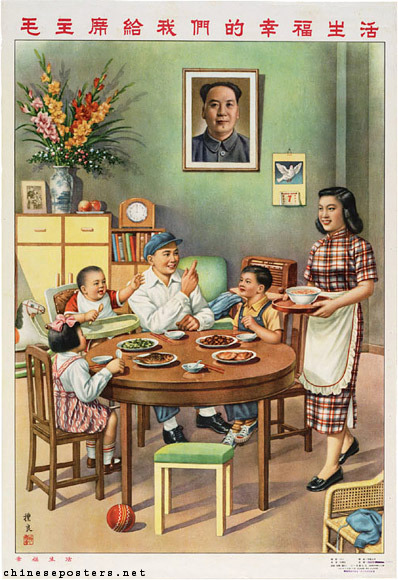
Source here or see watermark
50s mainland housewife in a cheongsam. You can also see with the children that the girl is wearing a skirt and the boy a pair of pants, gender denominators were not dead.
Another feminist tangent because this is my blog. I hate how fashion historians describe the masculine looking uniforms and “Mao suits” in the communist era “androgynous” like no they weren’t fucking androgynous they were masculine. Androgyny means showing both masculine and feminine elements but somehow feminine fashion is never represented in “androgynous clothing”. Don’t try to pull that “uhh feminine clothing is not practical” card, like so what? Does the definition of “androgyny” include “practicality”? Obviously not, it’s just an excuse to exclude femininity. It’s that age old misogynistic thing of treating masculinity as the neutral norm or “not having gender” and femininity as the cursed variation with gender added to it. If clothing in the communist era was truly unisex or androgynous, why do we have no evidence of cis guys roaming about the streets in cheongsam or platye?? I think a lot about this video on androgyny by Jade Fox.
It was the flip side in Hong Kong, as the cheongsam continued its function as everyday wear which lasted until the late 1960s. The cheongsam in the 1950s and 1960s became even tighter fitting to further accentuate feminine curves. Western clothing became the default after the late 1960s, though the cheongsam continued to survive as uniforms for students (who donned a looser and androgynous version), waitresses, brides, and beauty contestants.
This is all pretty standard and correct, my only two bones to pick are the “feminine curves” and “androgynous version”. I already explained my problem with modern interpretation of androgyny, a looser cut does not equal androgyny. The thing about feminine curves is true on the surface but if you think deeper about it the 50s/60s cheongsam doesn’t show the “real”, biological female body but rather an hourglass ideal artificially created by shapewear that people are taught to perceive as feminine. The Hong Kong cheongsam didn’t accentuate feminine curves so much as invent them, because curves are not a necessary prerequisite for femininity anyway. There is absolutely nothing wrong with this, fashion is all about different silhouettes, but can we just stop giving inanimate pieces of fabric or shapes gender like all of this belongs in r/arethecisok.
I’m not gonna analyze fig 21 because everything was possible after the 1970s and this drawing looks pretty good. That’s all :))
Conclusion
Woah this got long. I had a lot of fun reviewing these drawings and I would say that overall Duong did a very good job for 2013 (please do not kill me I mean no harm :.3). The main takeaway here is to not consult 5000 Years of Chinese Costume for anything ever, it leads only to pain and tears... I guess this post also functions as a partial review of 5000 Years then? I should rate it too. Solid 3/10 from the passages included here, would not recommend. If you want to learn about Chinese fashion history, read more recent books, at least from 2000 onward the bar is very low.
586 notes
·
View notes
Text
Avatar: Cultural Appreciation or Appropriation?
I love Avatar: the Last Airbender. Obviously I do, because I run a fan blog on it. But make no mistake: it is a show built upon cultural appropriation. And you know what? For the longest time, as an Asian-American kid, I never saw it that way.
There are plenty of reasons why I never realized this as a kid, but I’ve narrowed it down to a few reasons. One is that I was desperate to watch a show with characters that looked like me in it that wasn’t anime (nothing wrong with anime, it’s just not my thing). Another is that I am East Asian (I have Taiwanese and Korean ancestry) and in general, despite being the outward “bad guys”, the East Asian cultural aspects of Avatar are respected far more than South Asian, Middle Eastern, and other influences. A third is that it’s easy to dismiss the negative parts of a show you really like, so I kind of ignored the issue for a while. I’m going to explain my own perspective on these reasons, and why I think we need to have a nuanced discussion about it. This is pretty long, so if you want to keep reading, it’s under the cut.
Obviously, the leadership behind ATLA was mostly white. We all know the co-creators Bryan Konietzko and Michael Dante DiMartino (colloquially known as Bryke) are white. So were most of the other episodic directors and writers, like Aaron Ehasz, Lauren Montgomery, and Joaquim Dos Santos. This does not mean they were unable to treat Asian cultures with respect, and I honestly do believe that they tried their best! But it does mean they have certain blinders, certain perceptions of what is interesting and enjoyable to watch. Avatar was applauded in its time for being based mostly on Asian and Native American cultures, but one has to wonder: how much of that choice was based on actual respect for these people, and how much was based on what they considered to be “interesting”, “quirky”, or “exotic”?
The aesthetic of the show, with its bending styles based on various martial arts forms, written language all in Chinese text, and characters all decked out in the latest Han dynasty fashions, is obviously directly derivative of Asian cultures. Fine. That’s great! They hired real martial artists to copy the bending styles accurately, had an actual Chinese calligrapher do all the lettering, and clearly did their research on what clothing, hair, and makeup looked like. The animation studios were in South Korea, so Korean animators were the ones who did the work. Overall, this is looking more like appreciation for a beautiful culture, and that’s exactly what we want in a rapidly diversifying world of media.
But there’s always going to be some cherry-picking, because it’s inevitable. What’s easy to animate, what appeals to modern American audiences, and what is practical for the world all come to mind as reasons. It’s just that… they kinda lump cultures together weirdly. Song from Book 2 (that girl whose ostrich-horse Zuko steals) wears a hanbok, a traditionally Korean outfit. It’s immediately recognizable as a hanbok, and these dresses are exclusive to Korea. Are we meant to assume that this little corner of the mostly Chinese Earth Kingdom is Korea? Because otherwise, it’s just treated as another little corner of the Earth Kingdom. Korea isn’t part of China. It’s its own country with its own culture, history, and language. Other aspects of Korean culture are ignored, possibly because there wasn’t time for it, but also probably because the creators thought the hanbok was cute and therefore they could just stick it in somewhere. But this is a pretty minor issue in the grand scheme of things (super minor, compared to some other things which I will discuss later on).
It’s not the lack of research that’s the issue. It’s not even the lack of consideration. But any Asian-American can tell you: it’s all too easy for the Asian kids to get lumped together, to become pan-Asian. To become the equivalent of the Earth Kingdom, a mass of Asians without specific borders or national identities. It’s just sort of uncomfortable for someone with that experience to watch a show that does that and then gets praised for being so sensitive about it. I don’t want you to think I’m from China or Vietnam or Japan; not because there’s anything wrong with them, but because I’m not! How would a French person like to be called British? It would really piss them off. Yet this happens all the time to Asian-Americans and we are expected to go along with it. And… we kind of do, because we’ve been taught to.
1. Growing Up Asian-American
I grew up in the early to mid-2000s, the era of High School Musical and Hannah Montana and iCarly, the era of Spongebob and The Amazing World of Gumball and Fairly Odd Parents. So I didn’t really see a ton of Asian characters onscreen in popular shows (not anime) that I could talk about with my white friends at school. One exception I recall was London from Suite Life, who was hardly a role model and was mostly played up for laughs more than actual nuance. Shows for adults weren’t exactly up to par back then either, with characters like the painfully stereotypical Raj from Big Bang Theory being one of the era that comes to mind.
So I was so grateful, so happy, to see characters that looked like me in Avatar when I first watched it. Look! I could dress up as Azula for Halloween and not Mulan for the third time! Nice! I didn’t question it. These were Asian characters who actually looked Asian and did cool stuff like shoot fireballs and throw knives and were allowed to have depth and character development. This was the first reason why I never questioned this cultural appropriation. I was simply happy to get any representation at all. This is not the same for others, though.
2. My Own Biases
Obviously, one can only truly speak for what they experience in their own life. I am East Asian and that is arguably the only culture that is treated with great depth in Avatar.
I don’t speak for South Asians, but I’ve certainly seen many people criticize Guru Pathik, the only character who is explicitly South Asian (and rightly so. He’s a stereotype played up for laughs and the whole thing with chakras is in my opinion one of the biggest plotholes in the show). They’ve also discussed how Avatar: The Last Airbender lifts heavily from Hinduism (with chakras, the word Avatar itself, and the Eye of Shiva used by Combustion Man to blow things up). Others have expressed how they feel the sandbenders, who are portrayed as immoral thieves who deviously kidnap Appa for money, are a direct insult to Middle Eastern and North African cultures. People have noted that it makes no sense that a culture based on Inuit and other Native groups like the Water Tribe would become industrialized as they did in the North & South comics, since these are people that historically (and in modern day!) opposed extreme industrialization. The Air Nomads, based on the Tibetan people, are weirdly homogeneous in their Buddhist-inspired orange robes and hyperspiritual lifestyle. So too have Southeast Asians commented on the Foggy Swamp characters, whose lifestyles are made fun of as being dirty and somehow inferior. The list goes on.
These things, unlike the elaborate and highly researched elements of East Asian culture, were not treated with respect and are therefore cultural appropriation. As a kid, I had the privilege of not noticing these things. Now I do.
White privilege is real, but every person has privileges of some kind, and in this case, I was in the wrong for not realizing that. Yes, I was a kid; but it took a long time for me to see that not everyone’s culture was respected the way mine was. They weren’t considered *aesthetic* enough, and therefore weren’t worth researching and accurately portraying to the creators. It’s easy for a lot of East Asians to argue, “No! I’ve experienced racism! I’m not privileged!” News flash: I’ve experienced racism too. But I’ve also experienced privilege. If white people can take their privilege for granted, so too can other races. Shocking, I know. And I know now how my privilege blinded me to the fact that not everybody felt the same euphoria I did seeing characters that looked like them onscreen. Not if they were a narrow and offensive portrayal of their race. There are enough good-guy Asian characters that Fire Lord Ozai is allowed to be evil; but can you imagine if he was the only one?
3. What It Does Right
This is sounding really down on Avatar, which I don’t want to do. It’s a great show with a lot of fantastic themes that don’t show up a lot in kids’ media. It isn’t superficial or sugarcoating in its portrayal of the impacts of war, imperialism, colonialism, disability, and sexism, just to name a few. There are characters like Katara, a brown girl allowed to get angry but is not defined by it. There are characters like Aang, who is the complete opposite of toxic masculinity. There are characters like Toph, who is widely known as a great example of how to write a disabled character.
But all of these good things sort of masked the issues with the show. It’s easy to sweep an issue under the rug when there’s so many great things to stack on top and keep it down. Alternatively, one little problem in a show seems to make-or-break media for some people. Cancel culture is the most obvious example of this gone too far. Celebrity says one ignorant thing? Boom, cancelled. But… kind of not really, and also, they’re now terrified of saying anything at all because their apologies are mocked and their future decisions are scrutinized. It encourages a closed system of creators writing only what they know for fear of straying too far out of their lane. Avatar does do a lot of great things, and I think it would be silly and immature to say that its cultural appropriation invalidates all of these things. At the same time, this issue is an issue that should be addressed. Criticizing one part of the show doesn’t mean that the other parts of it aren’t good, or that you shouldn’t be a fan.
If Avatar’s cultural appropriation does make you uncomfortable enough to stop watching, go for it. Stop watching. No single show appeals to every single person. At the same time, if you’re a massive fan, take a sec (honestly, if you’ve made it this far, you’ve taken many secs) to check your own privilege, and think about how the blurred line between cultural appreciation (of East Asia) and appropriation (basically everybody else) formed. Is it because we as viewers were also captivated by the aesthetic and overall story, and so forgive the more problematic aspects? Is it because we’ve been conditioned so fully into never expecting rep that when we get it, we cling to it?
I’m no media critic or expert on race, cultural appropriation, or anything of the sort. I’m just an Asian-American teenager who hopes that her own opinion can be put out there into the world, and maybe resonate with someone else. I hope that it’s given you new insight into why Avatar: The Last Airbender is a show with both cultural appropriation and appreciation, and why these things coexist. Thank you for reading!
#this deleted idk why#so here is me reposting it#atla#avatar#avatar the last airbender#cultural appropriation#meta#atla meta#racism
786 notes
·
View notes
Text
I kinda wanna do my own mini rant in the spirit of the rant about Ringdolls nazi stuff.
For years now we’ve been all educated, and educating on many huge issues in the world. How to be more accepting, and mindful of others. What I just wanna make clear is, that we’ve had a much bigger focus on just, learning, and accepting, or at least understanding different views, and experiences, from the present, but also the past.
One thing that kinda irks me, which this hobby obviously has a problem with, but I also know many other hobbies must do too, is how people will excuse racism, sexism, or just downright historical cruelties, and whatnot, just because the person wasn’t born in the west.
Just an example
Imagine if a Western artist, or a Western BJD company, started producing dolls wearing the Japanese Red Sun, or imagery with strong resemblance to it, and uniforms of that time, and then sold them to East Asia. Imagine selling them to S Korea, China, Philipines, and so on. That’d obviously cause a huge issue, because historically, it’s just a very offensive symbol, which to some East Asians, and just Asians, can be viewed close, or just like the Nazi-Swastika. I obviously can’t confirm this, but from what I’ve seen, and heard, it’s a really bad symbol to people in many Asian countries.
In the West, we might not even realise that, even if we know some of the history of Asia, because we just aren’t as close to it. But I think many people are at least somewhat aware of certain military historical symbols, and actions, and what they meant for people.
I highly doubt many people in our Western part of the hobby would accept that, and would probably call out the artist, and wonder why the hell they’d make something like that, when it’s clear that this symbol is incredibly offensive to the people of a large part of Asia. You’d obviously come across information, and hints, when researching a certain topic, especially when it’s very gruesome, and had a big impact in some way.
So why is it fine for a Chinese company, Ringd0ll, to produce Nazi inspired clothing? Why is it that we in the West should basically “accept” or “mind our own business” when this stuff happens? Why do people excuse the actions of this company, or even companies? Allegedly Iplehouse had a very clear Nazi imagery featured in one of their dolls fullsets at some point.
I’ve even seen small Asian artists make Nazi uniform pieces, with the Eagle on the Swastika and all.
We know it’s not hard to figure these things out. And I’d say, that especially in circumstances like these, where the issue isn’t some small, insignificant historical event, but something that impacted the whole world!, everyone knew about it, it’s WORLD WAR 2! people should research, and frankly, get educated before making these things. And then immediately realize why they shouldn’t make them.
Or at least listen to the people, who try and educate why that’s just incredibly offensive. And I mean offensive, as in actually offensive, not someone getting their ego bruised, this is people calling out people using Nazis as a doll fashion statement.
I especially don’t understand, that even Westerners will make excuses for Asian companies, and people. It almost comes across as infatalizing, because they treat it like Asians just “don’t know any better.” or that they’re somehow not educated enough to know, or figure out who the Nazis were, what they did, and why it’s so horrific to be, in a way, putting them on a pedestal, by creating dolls in their image.
Fact is, if you are able to make Nazis uniforms, based on historical, or even modern media, you’re also able to figure out why it’s an incredibly offensive thing to do.
And in regards to there even being Western doll owners who feel comfortable enough to make dolls dressed as Nazis, and posting them online, in public spaces. This is what the people who accept, and excuse this are doing. You’re not being “accepting of culturally different views.” you’re just accepting the of glorifying Nazis, and their deeds. Because you acknowledge what these dolls represent, and you excuse it.
And I know the argument is gonna arise “So are you claiming you’re always glorifying something, when you create something based on something else?”
The thing is, this is a very nuanced type of situation. If I made a doll who’s based on a horror movie figure, I’d not be glorifying the deeds of that character. I’d show either appreciation, or something in that vein, based on that character, the writer, and the story it came from.
If someone creates a character based around the idea of someone like Jack the Ripper. That’s kinda fucked up, not going to lie, but in most cases it’s clear that people are more obsessed with the deeds, rather than the person. They see the name “Jack THE RIPPER!” and think it’s somehow cool, and edgy to make a doll based on that, on the name. Most people aren’t aware of much besides that. They are more glorifying the idea of the figure, the “mystery”, the lore that was created around the figure titled Jack the Ripper, than the actual person itself.
When you make something based on Nazis, you know what’s going on. You know what it all symbolizes. Everyone knows it, or at least a large part will know, who’ll also have a good amount who’d immediately try to tell you why that’s fucked up. There’s nothing you can remove from Nazis, that isn’t gonna still make it clear you’re still glorifying a Nazi, or the concept of Nazis, because everything involving them, is steeped in that Nazi imagery, and history.
+ Just wanted to add, from the point about Jack the Ripper. It’d be a different thing if it was someone like Charles Manson, or Albert FIsh, you can’t remove what you created, from glorifying what these actual people did. You can’t, you’re just glorifying their deeds, because there’s not “mysterious” figure, there’s no lore made by overeager writers, or mysterious names that basically create a character completely removed from the person, because people didn’t know much, or even nothing at all. At that point, you’re glorifying horrible people, who are looking you straight into the eye, with their histories, and their deeds, clear cut and dry.
I’m not sure if that last part made much sense to many, but I tried explaining it to the best of my ability.
~Anonymous
25 notes
·
View notes
Text
Twenty-two women architects and designers you should know
To mark International Women's Day, we asked 22 of the world's most inspirational women architects and designers to nominate another woman who should be better known for their work.
Each of the prominent architects and designers was asked to select a woman who they think deserves greater recognition.
Several chose to shine a light on historic figures who did not receive full recognition in their lifetimes, with MVRDV co-founder Nathalie de Vries, Bangladeshi architect Marina Tabassum and Neri&Hu co-founder Rossana Hu nominating Jadwiga Grabowska-Hawrylak, Minnette de Silva and Lin Huiyin respectively.
Others took the opportunity to draw attention to a contemporary woman or women-led team that should be better known, with Camille Walala, Tatiana Bilbao, Dorte Mandrup and Eva Franch i Gilabert nominating Unscene Architecture, Taller Comunal, Marie-José Van Hee and V. Mitch McEwen respectively.
Read on for the 22 architects and designers that deserve greater recognition:
Marie-José Van He
Nominated by Dorte Mandrup, Dorte Mandrup Arkitekter
"Marie-José Van Hee is a remarkably talented architect. Working primarily in her native country, Belgium, she is forging a significant mark on contemporary architecture with her attention to space, light and natural materials.
"Through her understated, authentic and poetic work, she continuously influences and inspires architects and designers alike. A timeless simplicity and weightlessness permeate throughout her designs, creating a stillness that seems almost tangible – blurring the line between art and architecture."
Iwona Buczkowska
Nominated by Farshid Moussavi, Farshid Moussavi Architecture
"Polish-born French architect Iwona Buczkowska's brilliant career is distinguished by an architectural approach opposed to any form of standardisation, thus placing the diversity of users and their agency at the core of her work. Her tireless commitment has led to the creation of works of incredible richness and inventiveness, whether for housing projects or public facilities.
"At a time when we need to question our built environment, and in particular, the housing in which we live, her work on diversification, user empowerment and inclusion seems particularly worthy of attention. As her work is under-studied, and because some of her built projects are currently under threat of demolition, I feel it is particularly important to bring to light what her work has to teach us."
Charlotte Perriand
Nominated by Es Devlin, Es Devlin Studio
"Last weekend I went to the South Downs to try to recreate this uplifting portrait of Charlotte Perriand (above) about which her daughter said: 'That photograph of a strong woman, triumphantly embracing nature, is the perfect image of my mother. She announces the contemporary woman, emancipated and free.
"Most of us have sat on the extraordinary and now iconic furniture she made in collaboration with Le Corbusier. Most of us are unaware of her fundamental role in its design. She was a genius in the art of collaboration, especially with powerful male artists. Her practice spanned an astounding range of genres, her work drew deeply on the forms she observed in nature throughout her rich life."
Kenyatta Mclean
Nominated by Harriet Harriss, dean of the Pratt Institute School of Architecture
"I'd like to nominate Kenyatta Mclean, co-founder and co-managing director of Blackspace: the black, interdisciplinary, spatial collective comprised of architects, artists, designers and planners who have asserted both the necessity and the agency of 'Black Urbanism'.
"From my perspective, her ability to co-create spatial narratives that are centred in and driven by racial justice is essential and urgent work applicable both to the US where the practice is situated, and cities worldwide, where structural racism and other forms of discrimination are embedded in the materiality and form of the architectures that surround us.
"Moreover, spatial collectives – from Matrix to Assemble – offer a much-needed antidote to the vagaries of starchitecture and the hierarchies typically found in traditional design practices. Kenyatta Mclean's visionary work reminds us all of the need to use this period of Covid-imposed introspection to re-examine how much more inclusive, equitable and impactful our industry needs to become.
"Blackspace also offers a road map and a benchmark for graduates and young practitioners who are committed to leading the changes we need to make."
Unscene Architecture
Nominated by Camille Walala, Studio Walala
"I would like to nominate Unscene Architecture. A pair of fantastic women that I met the year before the pandemic started. The architecture design duo – founders Manijeh Verghese and Madeleine Kessler – were the co-creators of the British Pavilion for the postponed 2020 Venice Architecture Biennale. Definitely, ones to watch."
Anupama Kundhoo
Nominated by Seetal Solanki
"A rare kind within the world of architecture. Anupama Kundhoo brings people a voice, materials a voice and building a voice that is beyond her own – an egoless practice. Traits that shouldn't be so rare actually, but she's paving the way for so many and hopefully many more to come."
Ndebele women
Nominated by Sumayya Vally, Counterspace
"In this tribe, we evoke women near and far – friends, ancestors and mythical figures – women who write, organise, imagine and build worlds into being. I chose to draw attention to the unrecognised architect genius of the Ndebele women – women who craft ritual objects and build and adorn their own homes. The calling of their names invokes the calling of millions of errant, unrecognised, other architects the world over – past, present and future.
"They are Maria Ntobela Mahlangu, Dinah Mahlangu, Johanna Mkwebani, Martina Maghlangu, Anna Msiza, Sara Mthimunye, Sara and Lisbeth, Pikinini and Sara Skosana, Anna Mahlangu, Letty Ngoma, Sarah Mguni, Martha Mtsweni Ndala, Rossinah and Esther Mahlangu."
Jadwiga Grabowska-Hawrylak
Nominated by Nathalie de Vries, MVRDV
"When working on our Concordia Design project in Wroclaw, Poland, I met Jadwiga Grabowska-Hawrylak, the grande dame of modern Polish architecture. Born in 1920, she brought architecture to the next level in the second half of the 20th century. In 1974, she was the first woman to receive the prestigious Honorary Award from the Association of Polish Architects.
"In a time when female Polish architects were mostly known as 'the wife of…' Jadwiga had a highly successful career, she had a big part in rebuilding postwar Wroclaw, and was also known for her schools and housing. I am really impressed by her work and her amazing personality. When I met her, she was very energetic and still very much involved in architecture. With her passing in 2018, Poland lost a great architect."
Minnette de Silva
Nominated by Marina Tabassum
"The first name that comes to mind is Minnette de Silva (pictured above with Pablo Picasso), an architect ahead of her time. Less celebrated than her contemporary male counterparts. You may have read this article below, but I'm sharing the link again. This tells her story better than I can write."
Marina Willer
Nominated by Margaret Calvert
"I would propose Marina Willer, although she may not fit as she's already well known. Apart from being an exceptional graphic designer and filmmaker, Marina was the first woman to be appointed a Pentagram partner. Brazilian by birth, it was at the Royal College of Art, where I was teaching at the time, that I first became aware of her amazing drive, commitment and talent as a student."
Duygu and Begum Ozturk
Nominated by Nelly Ben Hayoun, Nelly Ben Hayoun Studios
"I nominate Duygu and Begum Ozturk, the two sisters behind the fashion brand Harem London. Born in Istanbul, they started their all-organic fashion brand recently in Dalston, London; merging traditional techniques from Istanbul and London, bringing together their heritage and future.
"I love that they started a business together as sisters and that they are persevering in developing their beautiful collection despite the pandemic and Brexit and all the complexity this created for them. They need to be applauded for their great work."
Lin Huiyin
Nominated by Rossana Hu, Neri&Hu
"Lin Huiyin was the first female architect in modern China. Lin and her partner Liang Sicheng were the pioneers in architectural heritage restoration and documentation in China during the 1930s.
"Although it was the two of them who brought China's ancient architectural treasures to light, Lin's recognition in documenting and restoring China's historic buildings has often been overshadowed by her partner, who is recognised as the 'father of modern Chinese architecture'. In addition to her architectural practice, Lin is also widely acclaimed for her literary creation."
Mary Corse
Nominated by Azusa Murakami, Studio Swine
"I would like to pick Mary Corse. She has been gaining much-deserved recognition in recent years with a solo show at the Whitney but has been arguably one of the most innovative artists to come out of the light and space movement.
"We love her material research, her ability to take industrial elements like the glass microbeads used on motorway reflective road markings and using it to make really delicate and sublime optical paintings is really inspiring."
Yemi Awosile
Nominated by Morag Myerscough
"I have loved Yemi Awosile's work for many years. She is a wonderful person and I have worked with her in the past on the Bernie Grant Centre where she made some textiles for the centre."
Franziska Porges Hosken
Nominated by Jane Hall, Assemble
"Austrian-born, and America-based, designer Franziska Porges Hosken was pioneering in multiple respects. In 1944 she became one of the first women to receive her master's of architecture degree from Harvard's Graduate School of Design and in 1947, together with her husband James Hosken, she founded their successful eponymous furniture business Hosken.
"Despite giving up her design practice to take care of her first child in the late 1950s, Hosken continued to create as a photographer and journalist, publishing numerous books on urbanism including The Language of Cities.
"She was also an activist for women's rights, founding the Women's International Network and publishing reports on Female Genital Mutilation (FGM), a term she is credited with coining, which affected the agenda of major health organisations including the WHO. Continuing to distribute a feminist newsletter well into her eighties, Hosken's legacy demonstrates an extraordinary commitment, undertaken over the course of a lifetime, to connect design with social activism."
Winka Dubbeldam
Nominated by Sonali Rastogi, Morphogenesis
"Winka Dubbeldam is an architect whose contribution I would like to acknowledge. She is the founder of the WBE firm Archi-Tectonics. She had visited our studio about 15 years back whilst working on the redevelopment of the New Delhi railway station. I also enjoyed attending one of her juries in UPenn about ten years ago, and ever since, I have been following her.
"Being in academia myself, what resonates with me is her significant influence on the emerging generation through her involvement in architectural education and design juries worldwide. Her designs are evocative and transformative, and she creates architecture that matters.
"I read somewhere that she maintains a fluid balance between energy and calm, precision and informality, experiment and comfort in her designs, studio, and life, a mantra I have been following all my life."
Eva Albarran
Nominated by Sofia Von Ellrichshausen, Pezo von Ellrichshausen
"I would like to propose Eva Albarran: a Spanish entrepreneur, living both in Paris and Madrid, who operates in the expanded, and diffuse, field of contemporary art and architecture.
"She is a solid character who has managed to solve complex productions for significant artists (such as Christian Boltaski, Felice Varini or Francis Alys). Together with her husband, they direct a refined gallery and the Solo houses program, a project that might well be read as a radical revision of the current human condition in relation to nature."
Dana Al Amiri
Nominated by Pallavi Dean, Roar
"Dana Al Amiri, the co-founder of Watab Studio, is a rising star in the male-dominated Saudi construction industry. I love her minimal pared design philosophy – practicing in a region that is infamous for opulent and OTT statements. She truly represents the next generation of regional architects that are defining Saudi's design identity."
Taller Comunal
Nominated by Tatiana Bilbao
"I would like to make Taller Comunal, which is led by Mariana Ordóñez Grajales and Jesica Amescua Carrera, my recommendation. Because for them, architecture is not a profession, it is a service to facilitate architecture to be produced by the people who inhabit it. That should be the future of our profession."
Anne Tyng
Nominated by Huang Wenjing, Open Architecture
"Anne Tyng immediately came to mind as a female architect that deserves much more recognition. Born in China in 1920 to missionary parents; a classmate of Eileen Pei and IM Pei — these two little details seem to have brought her closer to me, my being Chinese and had worked in the office that IM founded.
"Tyng was one of the first women to study architecture at Harvard Graduate School of Design; the only woman to take the architectural license test in 1949.
"It is unfortunate and unfair that people often seem to be more interested in her anecdotal affair with the iconic master Louis Kahn than her great influence on his early works — the rigour of geometry and order was very much Anne Tyng's interest and contribution. She went on to be an independent architect, theorist and educator. A true pioneering woman in the field."
V. Mitch McEwen
Nominated by Eva Franch i Gilabert
"Mitch is an architect, activist, dancer, rapper, entrepreneur, someone who has taken the lead on many occasions to make space for new ideas.
"We crossed paths several times throughout the last ten years; In 2011, during the Occupy Wall Street Movement, I organised an exhibition and a series of events at Storefront for Art and Architecture hosted by brilliant people; Mitch's workshop "How to Occupy a House in America" was one of them.
"In 2014, Mitch was one of the architects writing letters to the Mayor in the first edition in New York of the global project "Letters to the Mayor" asking Mayor Bill de Blasio: "How can New York City Housing Authority really become the Pride of Our City?" and provided some answers and ideas that still stand.
"Mitch is currently an assistant professor at Princeton University – where I am currently teaching a seminar. Her work is now on display at MoMA in New York as part of Reconstructions: Architecture and Blackness in America."
Mónica Bertolino
Nominated by Sandra Barclay, Barclay & Crousse
"Mónica Bertolino is an architect from Córdoba, Argentina, where she lives and works as part of the Studio Bertolino-Barrado founded in 1981.
"Together with Carlos Barrado they have an excellent production of projects in different scales. In their work you understand immediately the search for good qualities in habitability, their sensibility when they intervene in the landscape, and their concern for research about materiality linked to the local traditions of construction.
"I admire and think she deserves recognition especially in her academic role where she transmits her passion and enthusiasm for architecture in an unconditional way. She is devoted to this mission!
"She participates in workshops and as invited professor in different universities in the world as well as a regular professor in the National University of Cordoba and in the Catholic University of Cordoba."
The post Twenty-two women architects and designers you should know appeared first on Dezeen.
6 notes
·
View notes
Text
20 in 10: A Drama Retrospective
Since I’ve been all quiet on the drama front this year because of life reasons, I thought it would be fun to go back and pick out 20 of the most memorable dramas of the last decade. Maybe not necessarily the best dramas or even my favorites (although some are!), but two dramas each year that were somehow notable moments in my drama-watching timeline.
2009: Gateway Drugs

Boys over Flowers (KBS)
This is not, by any stretch of the imagination, a good drama. It is not one I think I can ever really rewatch (although I will happily revisit the 2005 Japanese version, and I had a hellava fun time watching the latest Chinese version). But! It was the first kdrama I remember watching, and the first step on the slippery slope of eventually becoming a Drama Addict. I mostly remember it being crazy popular on places like mysoju (RIP), and so I checked it out due to curiosity, and the rest, as they say, is history. Or, should I say, almost paaaaradise!

You’re Beautiful (SBS)
This one I also watched because it became crazy-popular online, and curiosity got the better of me. I really didn’t know much about k-pop prior to dramas, so I had no idea until after this drama that k-pop was more about pretty people in crazy fashion, dancing in syncopation in bizarrely lit rooms, rather than playing instruments. Because it was thanks to this drama that I got my crash-course on k-pop as a phenomenon -- both the fandom side, and the crazy things that artists have to go through to claw their way into the public’s view (nevar 4get the glorious ramen dance). Since Angel was a group that played instruments, and Hongki and Yonghwa were also from groups that played instruments, I assumed that all kpop were groups that played instruments. Oh, sweet summer child...
But it did get me started on my k-pop journey, first falling in love with FT Island and CNBLUE, before falling into the rabbit hole of the other prominent groups of the day. (SNSD! The Wonder Girls! Super Junior! DBSK! SS501! Kara! 2PM! 2AM! Shinee! BEG! Epik High! U-KISS! All the debut groups, like 2NE1, MBLAQ, B2ST, 4Minute, f(x), T-ara, After School... basically 2009 was a magical year in k-pop.)
If I had just watched Boys Over Flowers, I don’t know that I would have become a Drama Addict. But You’re Beautiful pushed me closer to the edge, with the zany humor of the Hong Sisters (and the desire for a pig-bunny of my own!). It would really be Coffee Prince that would push me over the edge, but that aired in 2007 so it doesn’t count for this list. But I had to mention it anyway, because, well, it’s Coffee Prince and where my love for Handsome Oppa began.
2010: More Than Candy
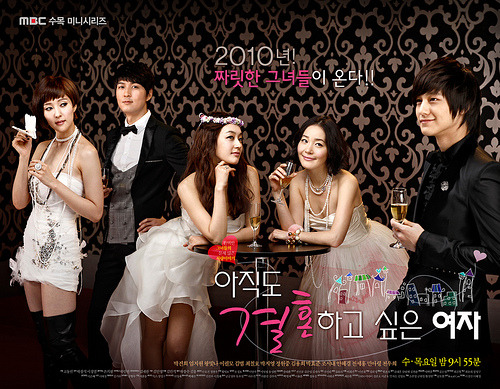
The Woman Who Wants To Marry (MBC)
A lot of the dramas I watched at first had that typical “Candy” character, the poor-but-scrappy girl who would somehow be saved by the guy and become the Cinderella she never knew she wanted to be. So it was a delight when I encountered women who were not only older than high-school-age or early twenties, but in their thirties, with rich full lives! Plus, this was one of my earliest introductions to the concept of the “noona romance” (a concept that I’ve since heartily embraced, of course). I started it primarily because Kim Bum was my favorite of the Flower Boys, but I stuck with it because I fell in love with the women (and I still have a girl-crush on Bu-ki).

Harvest Villa (tvn)
This show is insane. But in the good way, the way that the writer intended, and not in the “are a bunch of monkeys typing this script?” train-wreck way. There was basically no buzz about this show, and I feel like I somehow accidentally stumbled over it, but it was love at first sight. I’ve never forgotten the late hours binging it, being so sucked into the story that I absolutely had to finish it as soon as I could, disappointed that there wasn’t more of it to enjoy when I finally finished, bleary-eyed and sleep-deprived, but satisfied.
I then later gobbled down this writer’s next drama, and her next drama, and the next, until everyone else finally realized thanks to Signal that Kim Eun-hee was as amazing a writer as I kept insisting to anyone who would listen (aka no one).
2011: To Binge or Not To Binge?
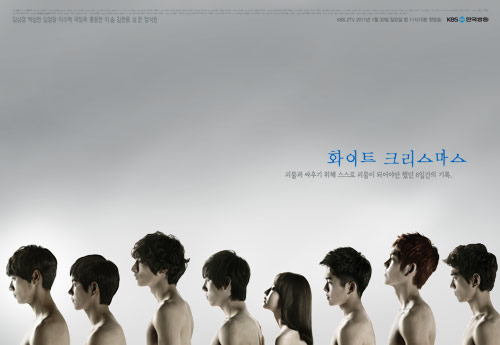
White Christmas (KBS)
I did not watch White Christmas in 2011. I actually watched it in 2013. I was always a steadfast binger, preferring to wait until the buzz about a show would sway me into spending my precious free-time watching something that would be worth my while (not that my drama choices were always good, but at least I tried to avoid the duds). I still prefer to binge, since waiting weeks for new episodes is vaguely frustrating when I want to know what happens next, right now! Plus, I’m very good at forgetting that I’m watching a show in the week-long wait for new episodes, and then just... never picking it back up again.
Despite watching White Christmas a couple years after it aired, it remains one of my favorites, and one I love to rewatch, even though I’ve already experienced whodunnit cliff-hangers and psychological rollercoasters. It became a tradition of sorts here on tumblr for a bunch of us to rewatch it over the holiday season -- alas, I haven’t joined in that tradition for the past couple of years, but I hope that somewhere in this blue hell hole that there are a loyal few keeping the tradition alive.
At least we have this drama to thank for bringing us all the model-actors that were new and clueless in White Christmas, but would later go on to be leading men in their own right. Of course, some of them haven’t exactly made the best drama choices (*cough*SungJoon*cough*), but then there are others (*cough*SooHyuk*cough*) that I’m impatiently waiting for to pick up a new drama so I can see those post-army abs.
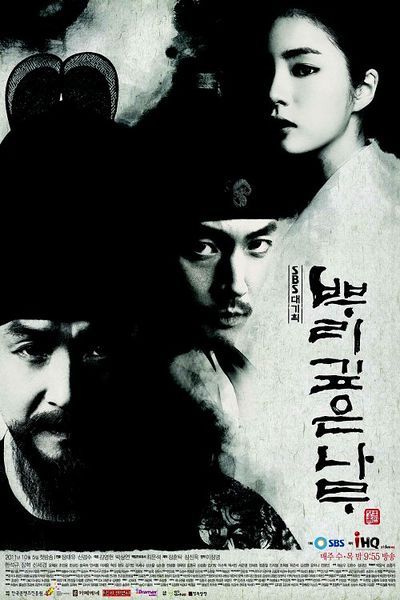
Tree With Deep Roots (SBS)
This is the first drama that I recall live-watching. I vaguely remember regretting it at the time, since it was agony waiting for new episodes, but it was also fun to have a week to speculate and ponder the show. And what a beautiful show to ponder! This was also one of the few sageuks I actually watched, being generally intimidated by anything longer than 16-20 episodes, and my historical knowledge was a little shaky (before embracing my inner nerd and diving into mundane historical stuff just so I could better understand whatever drama I was watching at the time).
I don’t think I intended to continue live-watching shows, preferring the ease of binging at my own pace and schedule. But that was when I was still a casual, innocent addict, and not someone who would eventually make dramas a huge part of her life.
2012: The Joy of Overthinking

Gaksital (KBS)
Having had a taste of live-watching, I started to live-watch enough dramas to the point where I began to make notes about the premiere weeks. It was only a couple at a time, and binging was still my preferred way to watch, but now I was delighting in being part of the fandom, sharing in speculation each week, posting my thoughts on dramas and analyzing them to my heart’s content -- even though I knew no one except me would read my ridiculous essays.
But I started to feel more comfortable sharing my opinion with the world, interacting with fandom and not merely content to be a consumer, but gradually becoming a producer as well.
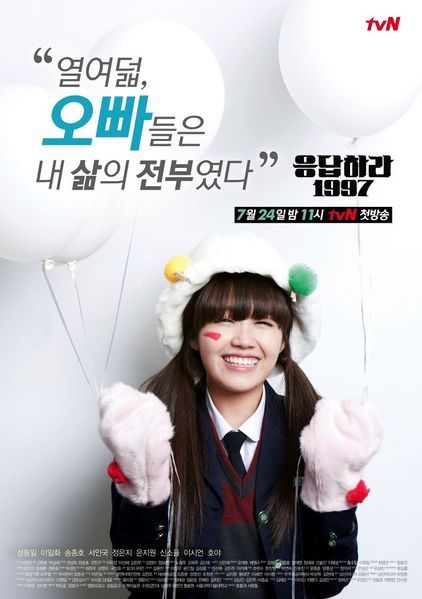
Reply 1997 (tvN)
This is it. This is when I went full-on Drama Addict. This is the tipping point from casual fan who quietly kept to herself, to becoming someone who stood on the mountain top yelling about ALL THE DRAMAS ALL THE TIME. I began to interact with other fans! To swap theories and share squee-worthy moments! I even watched episodes RAW just because of how desperate I was to know what happened, and even though the Busan accent stumped me more than once, it made me realize that my casual study of Korean was something to take seriously since I understood more than I gave myself credit for.
It was also the first time any post I made got more than a handful of notes, since I’d mostly hovered in the “less than 10 notes per post” category at the time. I was so proud of myself back then!
(This drama also notably marks the start of my Hoya obsession, which continues to this day.)
2013: Tumblr Friends (and Foes)

Flower Boy Next Door (tvN)
Having made myself comfortable on tumblr as a Drama Addict, I then discovered some other dedicated fans -- many of which I still follow to this day and who are now just a permanent part of my dash, no matter what their current interests may be -- in the FBND squad.
But I also discovered Kim Seul-gi as the Webtoon Editor (who I still love and adore and continue to use as my avatar), and her adorable romance with Dong-hoon remains one of my forever OTPs. As much as I enjoyed the drama romances, I’d never fallen so deeply for one to be so obsessed by it as I was Webtoon Editor and Dong-hoon. And tbh I still am. They’re just so adorable and pragmatic and she buys him a bag. Ugh. I love her so much, you guys.
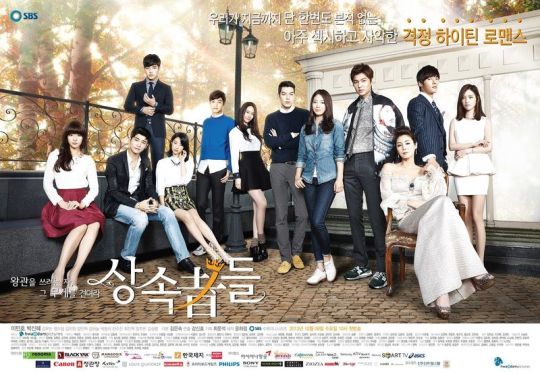
Heirs (SBS)
Ah, yes. This hot mess.
I don’t know what possessed me to live-blog each episode. But I did. With snarky commentary and terrible screencaps. And suddenly I went from maybe 200 followers to over a 1000. That was a total shock! I met a lot of people because of that (and made some friends, as well as a few enemies who didn’t appreciate my opinion of certain characters), and ensconced myself as part of the drama-blogging crew.
It was from this that someone suggested I apply to be a minion at Dramabeans. Back then, I had a lot more free time than I do now, and I was watching a lot of dramas that Dramabeans didn’t cover, and wished they did so I could read more opinions about those shows. So I thought, “Eh, why not? It can’t hurt to submit something because the worst that would happen is I’d waste their time making them read my take on episode 10 of Let’s Eat.”
I fully expected them to turn me down. No one was more surprised than I was when I found myself agreeing to dive into the world of recapping.
2014: It Was the Best of Times, It Was the Worst of Times
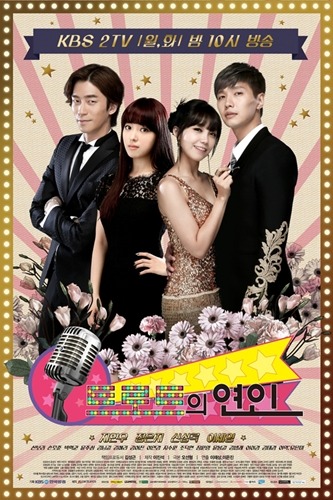
Trot Lovers (KBS)
Recapping. It seems so easy when you’re reading the recaps. But actually creating them is a bitch. Hours out of my life were spent on this disaster of a trope-laden show with no plot. This was the third show I worked on for Dramabeans, and I hated it to the point where I seriously considered handing in my notice. (Immediately following up this show with the mediocre My Secret Hotel certainly didn’t help matters!)
However, it turns out that what I actually hated was being forced to watch a terrible rom-com and pretend to come up with insightful-or-at-least-neutral thoughts about it (since we were still new and couldn’t go full-on snark yet).

Misaeng (tvN)
This is what saved me. Being given the chance to immerse myself in such a unique, ponderous, thoughtful show restored my faith in dramas and the drama community. I loved spending hours on this show, soaking up all the little details, and then sharing that love with the world.
Misaeng made dramas magical again.
2015: Fight Me

Valid Love (tvN)
Realizing that I only seemed to enjoy rom-coms at arm-length, I discovered that my tastes often ran counter to the general drama-viewing public. Not all the drama-viewing public -- I’m not a “not like other fans” kind of fan -- but enough that I began to realize the whether a drama was popular or had good buzz was not necessarily the primary reason to watch it.
I began to have more faith in my own taste, based on past experiences with various writers and directors. Even if the premise (or first couple of episodes) seemed kind of weird and out-there, I at least wanted to give these artists the benefit of the doubt that I would enjoy their work, like I had previously.
So many people seemed to hate Valid Love, but I adored it. Still do (and still desperately wish Kim Do-woo would come out with a new drama -- it has been too long, writer-nim!). There were a lot of opinions about this show, even among people who seemed to enjoy it, but I vividly recall having to repeatedly insist that it wasn’t about the romance and argue that the knee-jerk infidelity-is-BAD opinions should make space for something more nuanced.
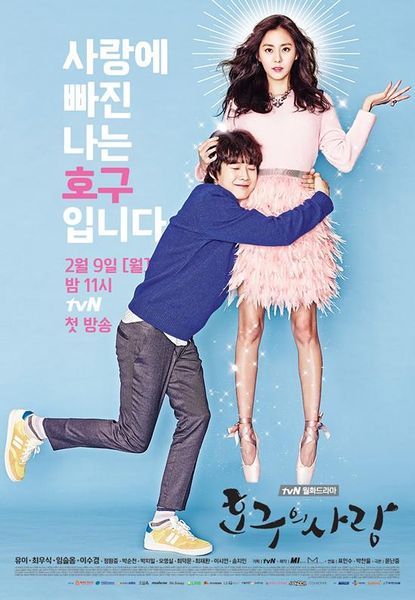
Ho-gu’s Love (tvN)
DramaFever was a pretty great site. It brought together so many drama fans and gave them a place where they could legally (and without fear of downloading random viruses) watch dramas to their heart’s content. Yes, there may have been some lingering resentment that they were the primary reason that so many amazing other sites were shut down (RIP mysoju and daebaeksubs), but dramas were more accessible than ever!
Eventually, DramaFever started to sub shows themselves and upload them weekly (instead of just using fansubs and uploading older dramas), and while they weren’t the best translations, they were at least better than machine translations from the Chinese subs. As I became more and more familiar with Korean, I found myself more likely to migrate to Viki since I liked the extra detailed translations. I could get the gist of a show without any help -- I wanted to instead delve into the nitty-gritty of the language.
But I never really hated DramaFever or felt they were particularly awful. Until they mistranslated something so terribly that it changed the entire meaning of a scene and ruined people’s perception of a drama, forcing me to continually defend the true translation.
That was the molehill I died on that day, and never again did I touch DramaFever. I feel bad that it eventually got unceremoniously shuttered. But I don’t think I’ll ever forgive them for the “condom” incident.
2016: Free Solo
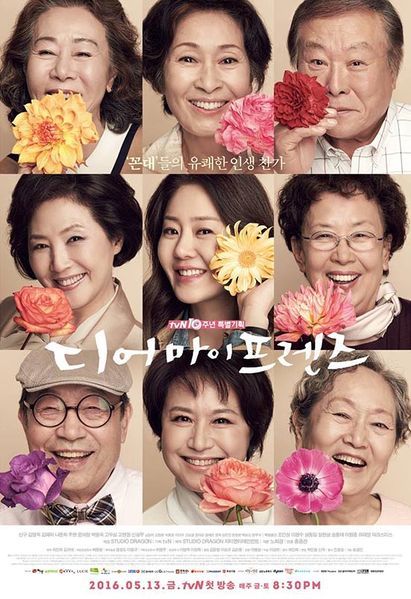
Dear My Friends (tvN)
For two years I’d been happily working on one episode a week, sharing a show with someone else, until I was asked if I’d like to tackle a show by myself. I wasn’t sure how I could handle it, but I had the time in my schedule so I said, “Sure, why not?”
I was originally going to recap Another Oh Hae-young, but there was a last-minute switcheroo, and I’m so incredibly glad because this is perhaps my favorite recapping experience of all time, even more so than Misaeng. There was something so special about the luxury of having an entire show to myself, especially one with such a fantastic cast of characters and thoughtful themes. I didn’t have to try and figure out if I agreed with another person’s take -- it could all be my opinion.
Is that arrogant? Perhaps. But it was also therapeutic, as it reminded me once again how incredible and amazing dramas could be, and the privilege I had to share such an exquisite and thought-provoking drama with the rest of the world.

The Good Wife (tvN)
Surprisingly, this was what I had really wanted to recap that year, and the true reason I got Dear My Friends, since it aired just prior in the same time-slot as The Good Wife. I was desperate to have this show, willing to do anything to get it because I needed to see Jeon Do-yeon back on the small screen, to see Yoo Ji-tae smolder, to know how Korea would adapt such an ambitious show.
And I wasn’t disappointed! This is, perhaps, my favorite adaption of another work of art that I’ve seen in dramaland. It remained true to Korean sensibilities, but it also properly felt like The Good Wife. The cast was phenomenal. The costumes were exquisite. I wished I could spend more time in that world.
But I was also thankful, because without The Good Wife, I would have never have had Dear My Friends.
2017: Serial-Killers Are Cool
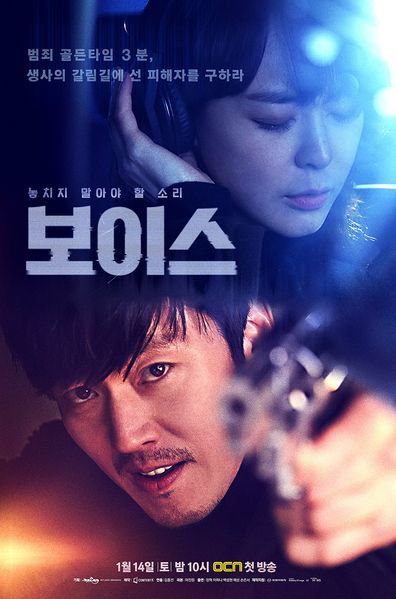
Voice (OCN)
I can’t remember how I got assigned to this. Maybe it was a scheduling thing. I do know that I really, really wanted it, since it would be Handsome Oppa’s first drama appearance in three years.
But it started me down a road of recapping a lot of serious and serial-killer-centric shows. Except for the times when I’d beg for a break and tackle something lighter, I was generally assigned the darker mystery shows with meaty plots, since apparently I had a knack for condensing complicated shows into something that made sense. (Also literally darker, and I eventually learned to automatically brighten every screencap I posted. You’re welcome.)
Not only did I love working on something with Handsome Oppa, I also had fun recapping the start of what would eventually become OCN’s stock-in-trade -- creepy serial killers. At the time, Voice shattered OCN’s viewer ratings (which would then be shattered again and again as more people would tune in to OCN shows). But Voice really helped put OCN on the viewership map -- as well as catapult Handsome Oppa into the public eye and lead him to a path of getting to choose whatever script he wanted to work on.
(Okay, maybe I made that last bit up, but he did begin to garner a larger following and remind everyone that just because he was gone from dramaland for so long, he hadn’t lost his acting chops -- or charisma -- or cheekbones.)

Black (OCN)
Oh, this show. It was basically my whole life while it was airing (well, the non-day-job part of my life). Each episode was over an hour long and jam-packed full of details that were pertinent to the story, and I had to somehow condense that all into 3000 words or less (I was not always, ah, successful...). It felt like I was back in recapping bootcamp, but the dial had been turned up to 11.
I’m weirdly proud of what I produced (although you’ll never get me to reread my old work). It was one of the most challenging shows to work on, but in the good way, not the Trot Lovers way.
Until the ending, that is. Sigh. That ending will live in infamy. I still, to this day, will get a few comments on the finale from people who watched it on Netflix, went searching online for an explanation of the end, and then discovered that they were not alone in being confused by the utter wtf-ery of the last twenty minutes.
2018: Fighting For My Love

Misty (JTBC)
So, Dramabeans kind of disappeared for a few months. Well, the site was still live. There were a handful of recaps. But... it basically just... stopped.
Those of us on the other side know about as you do as to why that happened. Minions are kept in the dark just as much as anybody, it seems. All we knew is that we weren’t being assigned anything and we seriously wondered if the site was going under, since adsense has become worthless these days.
But Mary and I kept talking about how much we adored Misty and were sad that we couldn’t talk about it with the world (and convince them to watch it with us), so we pleaded and begged and got the go-ahead to do a kind of chatty “open thread” which has apparently been a spring-board format for other shows. We didn’t get paid for this, and we were totally fine with that. We just wanted to provide some kind of content (while swooning over Kim Nam-joo’s pantsuits!).
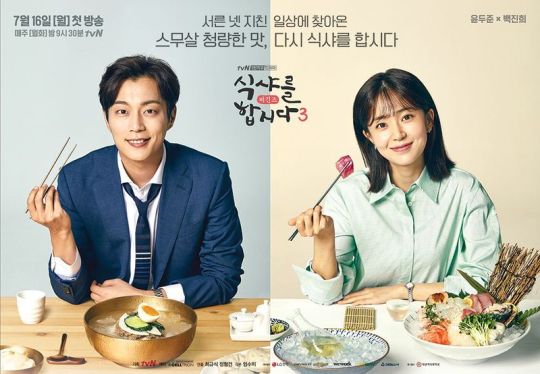
Let’s Eat 3 (tvN)
This was my first real assignment after the dead period, and I once again got to do full recaps (with pay!). I started watching, thinking I’d merely tolerate the show (since I loved the first season vastly more than the second season), but it turned out to be my favorite of the three. Plus it felt fortuitous that the series I had submitted my application would be a series I’d work on four years later.
Sometimes it’s nice to spend time with a character you met years ago, to see them grow, to see how they became what they became. Drama trends (and love interests) will come and go, but Goo Dae-young’s love of food (and love of explaining the proper way to eat food) will never change. It was a really comforting drama for me to spend my summer on, and I’ll remember it fondly, even if I’m forever sad that it had to suddenly wrap-up two episodes early.
2019: Ten Years Later
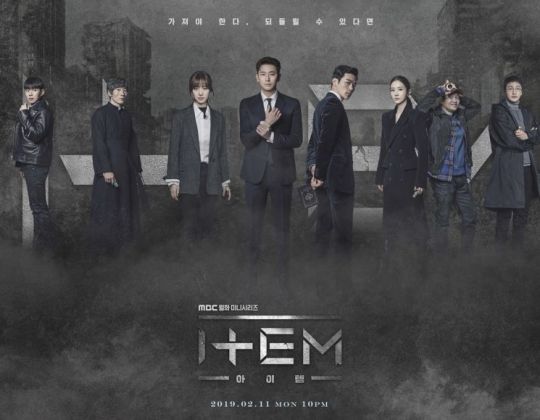
Item (MBC)
This was the Trot Lovers of 2019. It was a nonsensical disaster.
I also had the added chaos of my real-life job -- one very different from the one I had when I was working on Trot Lovers -- as it began to increase exponentially in responsibilities and in stress. I reached a breaking point where I began to hate opening my computer where I’d have to spend hours attempting to explain a show that I wanted nothing to do with. I was miserable and depressed and couldn’t do it anymore. I never before asked to be taken off a show because I hated it so much, but there’s a first for everything.

Her Private Life (tvN)
I actually haven’t finished this show -- I’ve yet to watch the last two episodes. But I’m including it because, well, I didn’t finish any other show in 2019 except for Item.
As some of you may know, this has been a difficult year. It started with the unexpected stress of my job, when we suddenly lost one of our directors who passed away, and another director was let go (in a complicated situation that is ongoing, but the important thing is that it was during our busiest time when we really couldn’t afford to lose anyone), and another director left for a different job and I was basically the one to pick up all the pieces she left behind. It was exhausting and we were all past the breaking point but somehow miraculously holding it together.
I was looking forward to finally getting a much-needed vacation in September, and then, well, you all know how that went: the first night, on our layover in New Zealand before what was supposed to be three weeks in Australia, my father was taken to the hospital, and then, two days later, he passed away. Life has gotten even more chaotic and stressful and bizarre since then.
So no, I haven’t finished this drama, but it was one of the most wonderful moments of the year for me, watching this fizzy rom-com with my favorite actor, where he got to be charming and handsome and charismatic and finally kiss the girl he loves and have her love him back (and not die or be dumped, as he had been in so many dramas that had gone before). Lion Oppa was everything my heart could desire, and living in his world helped me endure the insanity that I wish I’d known would seem so much more tolerable than what would eventually befall.
Her Private Life reminded me of when I first fell in love with dramas ten years ago, when I would giggle and be delighted by the charming nonsense on screen -- of beautiful people falling in love and fighting against the obstacles between them (some more ridiculous than others, perhaps, but there are always obstacles), and ending up happily ever after. Pure escapism, of the frothiest kind.
A Drama-filled Decade
So, after ten years of dramas, what is the takeaway? What have I learned?
I suppose I’ve learned to trust my instincts and put more faith in writers and directors than actors. That analyzing dramas is fun, and it’s even more fun sharing it with others, and sometimes even more fun if you get paid to do it -- but everyone eventually reaches a breaking point. That I’m too earnest and optimistic to embrace a life of snark. That I want every drama to be good but most of them aren’t, except sometimes they are. That I’m not even sure which genres are my favorite; I just know what I don’t like.
That dramas are best as escapism, and not as work.
I don’t know how many dramas I’ll watch in 2020. I haven’t paid any attention to what’s airing, and I’m okay with that. Perhaps I’m entering a new phase in my life, or perhaps I just don’t have the capacity to escape right now.
But I am pleased to have had dramas in my life, and to have eventually made them my hobby. I’ve met a lot of amazing people and made some genuine friends through a shared love of dramas (or, at times, a shared hatred). I’m honored that all of you are still here and following me, even during this period of fandom silence.
May 2020 treat us all better, and may Kim Do-woo finally write another script.
#kdrama#k-drama#retrospective#drama retrospective#dramabeans#boys over flowers#you're beautiful#the woman who wants to marry#harvest villa#white christmas#tree with deep roots#gaksital#reply 1997#flower boy next door#heirs#trot lovers#misaeng#valid love#hogu's love#dear my friends#the good wife#voice#black#misty#let's eat 3#item#her private life
116 notes
·
View notes
Text
My Fav Books, another chaotic list
Another quarantine review fest! I know I ranked my top anime but this is seriously too hard so I’m just going to list them to avoid hours of debate. Enjoy!
1) The Skulduggery Pleasant series
This whopper of a series (now at 15 books jesus christ I didn’t know there were that many I’ve only read about twelve) has a special place in my heart. I was FULLY obsessed with it throughout my tween - and teen - years, and for a reason. This shit just butters my bread like nothing else. The story follows a young girl Valkyrie Cain (who eventually becomes a young woman through the series) and her partner in crime, a fashionable living skeleton called Skulduggery Pleasant. They’re MAGICAL DETECTIVES!!!! Bitch!!! They use elemental magic - water, earth, fire, air - to fight off magic-wielding bad guys and look good doing it. The duo is hilarious and seriously shaped my sense of humour, the dry wit and comedic writing style stuck with me and influenced my own writing style to this day! As the series progresses we get a massive cast of characters but to me they’re all memorable, likable (mostly) and well-developed so that’s not an issue. I have no fukcing clue how Derek Landy comes up with his stories because every book in the series has an absolutely wild (yet unique) plot with its own twists and turns. It gets REALLY dark and depressing at times, gory, brutal etc etc especially in the later books I have no idea why this is labeled as a kids series.
10/10 for badassery, humour, and MAD codependency issues
2) The Feverwake series
This bitch is one hell of a YA series. It’s actually only a 2 book-series which is rare, but that’s not the only thing that sets it apart from other creations of its genre. It’s hard to explain the setup without waffling so I’ll just quote the blurb of the first book: “In the former United States, sixteen-year-old Noam Álvaro wakes up in a hospital bed, the sole survivor of the viral magic that killed his family and made him a technopath. His ability to control technology attracts the attention of the minister of defense and thrusts him into the magical elite of the nation of Carolinia.
The son of undocumented immigrants, Noam has spent his life fighting for the rights of refugees fleeing magical outbreaks—refugees Carolinia routinely deports with vicious efficiency. Sensing a way to make change, Noam accepts the minister’s offer to teach him the science behind his magic, secretly planning to use it against the government. But then he meets the minister’s son—cruel, dangerous, and achingly beautiful—and the way forward becomes less clear.”
As you can tell from this, the series is heavy on its politics but in a grounded, realistic and relevant way which is different to many other YA series. Marxist theory is brought up, and you can make some pretty strong links between the books and real events. The magic also has a semi-scientific explanation which is cool and adds to the realness. Anyways this series is action packed and full of twists, plus there’s a bisexual main character and queer romance at the core!! Wig!!! Very good for moral debate - how far is it acceptable to go to protect the oppressed before you become one of the oppressors? Dark and exciting series.
10/10 queer representation and political themes.
3) Spin the Dawn
It’s probably obvious that I’m biased towards YA books but they’re just so exciting and cool! Anyways this is about a girl living in a kind of alternate universe ancient China where magic exists. Maia Tamarin is a skilled seamstress who dreams of being the Imperial Tailor, a position that can only be held by a man. She poses as her brother to go to the royal palace and enter a competition full of skilled tailors, all vying for the role of imperial tailor. She also meets Edan; a mysterious, annoying, but SEXY mage who seems to know her secret identity? Oho? IMO this would be an elevated book if Edan had been a girl but that’s just me being gay. As the final challenge Maia is tasked with making 3 dresses from the sun, moon, and stars - a mission that takes her to the ends of the world in search of these magical materials (obvs Edan goes with her and they kiss kiss fall in love). It’s a fairly classic YA plot and characters but the combination of Project Runway, Mulan, and kind of Lord of the Rings(??) vibes makes for a very entertaining read. It’s also really fun to imagine what the clothes look like, plus the romance between Maia and Edan is very cute. Second book is yet to be published but sounds lit.
10/10 magic fashion and romance (despite its heterosexuality)
4) Aristotle and Dante Discover the Secrets of the Universe
Usually I steer clear of angsty gay stories because I’ve consumed too much of the depressing narrative which is all about suffering because of being gay, but fuuuuuuck this book is like the definition of bittersweet. Mostly bitter to be fair but it has a happy ending which was lovely after the emotional torment of the book. It’s about two teen boys - Aristotle is angry and repressed, Dante is eccentric but kind, and the two eventually form a strong friendship after meeting at the local pool. It’s kind of obvious that Ari is in denial about a few things, which leads to some real sad boi hours. There’s also a devastating moment around halfway (not sure) through with a car accident which makes the whole thing 10x heavier. Despite all this, the book has its sweet moments - parents play a big role, but not in the way they usually do in queer stories - and like I said the ending is the bandage for your broken heart. I’m not sure what it is about the writing style, maybe the way it just cuts between scenes randomly or perhaps the way the dialogue and actions are so realistic, but it’s so different to any other book I’ve read that it’s stayed in my mind for a while after reading it.
10/10 really good philosophy plus supportive parents
5) The Gentleman’s Guide to Vice and Virtue
Okay if this was a ranked list, this bad boy would be on its way to the top spot. It’s got everything: historical setting, gays, pirates, alchemy, humour, adventure, angst, character development, and some healthy second-hand embarrassment. It’s not complicated or philosophical but reading this book all in one go is like taking five shots and diving into a pool. It’s exciting and witty, but deals with darker themes like child abuse too. One of the MCs also has a disability and doesn’t treat it as something to be cured, which is a lesson our protagonist has to learn. Speaking of protagonists, Henry ‘Monty’ Montague is a great main character. He’s obnoxious, oblivious, and hedonistic yet quick-witted and passionate, and he has a good heart. Sometimes you just want to grab him by the shoulders and shake him for being such an ignorant idiot, but throughout the book he grows and learns to open his mind more (as well as becoming more humble). He’s a great example of a flawed yet likable main character. He is also a bisexual icon.
Oof forgot to even talk about the story. Monty embarks on a tour of Europe, usually taken by lads his age to get all cultured before they settle down and inherit the family company or whatever. With him are his younger sister Felicity, a girl with a brilliant mind for science who isn’t taken seriously by anyone because of her gender, and the lovely Percy, Monty’s lifelong best friend (and crush). Monty ends up stealing a very valuable object that turns the Tour into a manhunt across Europe, and drags the trio into a big ol’ conspiracy involving something that may or may not be the philosopher’s stone????
Issues of race, gender, and disability in historical context are really well done, and it’s an absolute banger of a book.
10/10 very exciting adventure, plus GREAT GAY ROMANCE
6) Heaven Official’s Blessing
HOOOOOO BOY. This is probably my absolute fave on this list. It’s a webnovel (originally Chinese but the full translation is online). Set in ancient china in the cultivation world (difficult as shit to explain if ur not into all of that but I’ll try), basically there’s three realms - the heavenly realm, the human/mortal realm, and the ghostly realm. If a mortal reaches a certain point (good deeds, power etc), they ascend to become a god - or if they fall far enough, they become a ghost.
I’ll just quote the author’s description again cause I don’t have the brain cells required:
“Eight hundred years ago, Xie Lian was the Crown Prince of the Xian Le kingdom. He was loved by his citizens and was considered the darling of the world. He ascended to the Heavens at a young age; however, due to unfortunate circumstances, was quickly banished back to the mortal realm. Years later, he ascends again–only to be banished again a few minutes after his ascension. Now, eight hundred years later, Xie Lian ascends to the Heavens for the third time as the laughing stock among all three realms. On his first task as a god thrice ascended, he meets a mysterious demon who rules the ghosts and terrifies the Heavens, yet, unbeknownst to Xie Lian, this demon king has been paying attention to him for a very, very long time.”
It’s hard to describe the enormity of this story and all the emotions it encapsulates, you really have to read it for yourself. But bitch the undying, pure, Hozier-devotion-level LOVE is by far my favourite part of this story. If you’re looking for an epic, god-tier gay romance, then this is it baby!! This story has comedy, action, and downright harrowingly depressing moments, but throughout is this achingly beautiful love between fallen god and last believer.
I don’t wanna give too much away cause there are some big ol’ plot reveals, but oooh this shit made me cry. The protagonist is MY FAVOURITE EVER I didn’t think it was possible to like a protag so much!! He’s legit my fave character! At first he seems oblivious and carefree but he’s just doing his goddamn best after all he’s been through and he’s so fukcing kind and just wants to help everyone for fuckcs sake excuse me I need to go have a breakdown.
Okay I’m back, anyway there’s a great cast of characters, even the background characters are all incredibly memorable and all given their time to shine and develop. My faves include Quan Yizhen, a rowdy himbo who just wants to fight, and Shi Qing Xuan, a friendly genderfluid god who controls the wind. Read this shit I’m not joking it’ll change your life.
10/10 for everything
3 notes
·
View notes
Text
History of Chinese standing collars (part 3: post republican era)
Quick recap: I was debating with myself whether “Mandarin collar” should be a thing because standing collars throughout Chinese history looked different. I went through the Ming and Qing dynasties in part 1 and the republican era in part 2, now I’ll look at what comes after that. I numbered the styles in parts 1 and 2 but they’re only guidelines so you don’t have to remember anything.
So in this post we’ve kind of reached the end of the era where fashion consisted of a single silhouette in any given year and all hell ran loose. I’m having a lot of difficulties classifying things as Chinese or Western because the distinction is really blurred, and I also ran into problems explaining why certain historical European things looked so similar to Chinese ones so there will also be a lot of confusion.
1950s & 60s Chinese application
Summary of 1950s fashion, mainland and others.
Because of the communist victory in the Civil War, fashion in the mainland was different to other (capitalist) areas populated by the Chinese diaspora such as Hong Kong, Macau, Taiwan etc.. Let’s look at capitalist area fashion first; I’ll be referring to Hong Kong because Hong Kong was the center of cheongsam making at the time.
Collars on 50s Hong Kong cheongsam grew taller on the basis of collar style 10 but retained the rounded, tapering edge, resulting in a v shape gap down the middle that weirdly recalls collar style 6 from part 1 and part 2. It’s basically completely identical to collar style 6 but stiffened and extremely form fitting. It’s usually closed with one pankou at the base but because of westernization, 50s cheongsam often had no visible pankou----everything is closed with snap buttons, zippers or hooks and eyes/bars. An important aspect of collars of 50s and 60s Hong Kong cheongsam is that they left out the binding around the neck. All cheongsam prior to this point were bound around the exterior edge, the side closure, the slits and the collar seam (on the bodice not the collar), 50s cheongsam collars purposefully neglected the binding at the collar seam for some reasons. This makes the collar look like it’s one continuous piece of fabric with the bodice, which it isn’t. A lot of modern representation of cheongsam or any Chinese inspired clothing (in video games, books and anime etc.) do this, even if the character is from before the 1950s. It REALLY bugs me. If you are an artist or writer and designing costumes for Chinese characters prior to the 50s, please include binding/trimmings on all three seams, it’s an easy way to bump up historical accuracy. With that said, completely plain collars without any binding or trim was actually the most common. Let’s call this collar style 13.
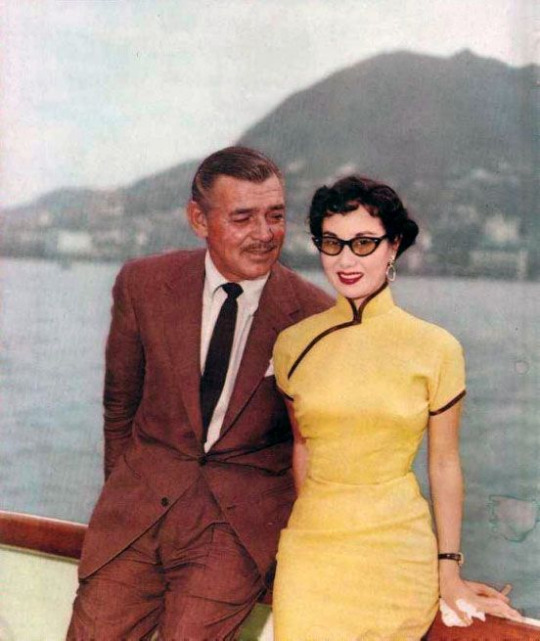
Source here
1954 photograph of Li Lihua and Clark Gable. Collar style 13 with stiffening and no collar seam binding. You can see how firm and neck hugging the collar is, contrary to a lot of modern cheongsam collars which are saggy and loose.
The popularity of collar style 13 continued into the 60s. When the cheongsam fell out of popularity, it ceased to exist as well.

Source here
60s cheongsam with collar style 13. I’m really not a fan of the nude/light lipstick trend of the 60s, like, as a person with no lip color definition it makes me look like a potato.
Now moving on to mainland collars. In the 1950s, cheongsam with the 40s collar style 12 were still occasionally seen, but the fashionable collar shape also became taller and was similar to the Hong Kong collar style 13. Interestingly, some 50s mainland cheongsam retained the binding around the collar seam, making them look more “traditional” in a sense. However, collars both with and without collar seam binding existed and it was just a matter of personal preference.
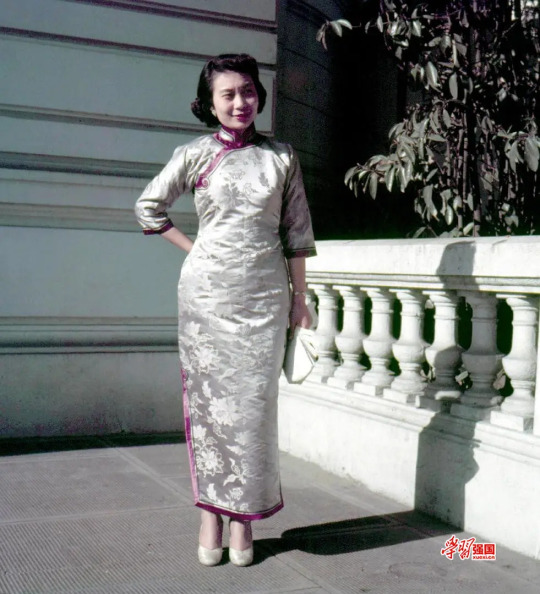
Source here
1950s photograph of a mainland lady in cheongsam. The collar is taller and closes with one button, much like Hong Kong collars of the era, but the neck binding is present.
Aoku robe collars from the 1940s onward mostly had the 40s style low collar, although in the 50s and 60s they rose in height very slightly.

Source here
1964 poster showing a girl in aoku, the robe has a low, rounded collar.
However, garments with a standing collar became worn a lot less frequently in the 50s and 60s in both mainland and non-mainland areas, since a lot of people adopted Western fashion.
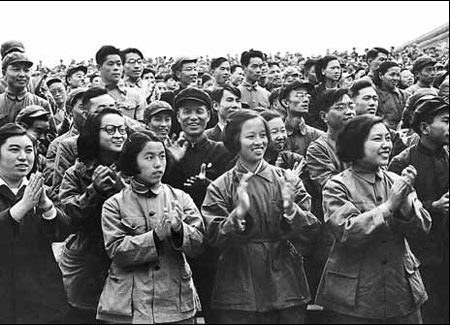
Source here
1950s photograph of a group of mainland people wearing jackets of Western construction. Some of them seem to be wearing informal military jackets, commonly known as “Mao suit” or “Zhongshan suit” nowadays, with folded collars.
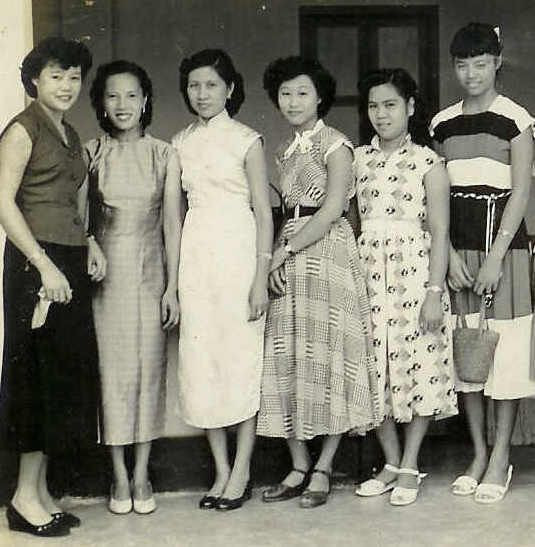
Source here
1950s photograph of some women in Malaysia, some in cheongsam and some in Western New Look dresses.
Western application
I think it’s also quite important to discuss how Chinese standing collars were perceived by Western designers, because the Western fashion industry does hold a lot more power globally and also reverse influenced Chinese collar designs in the post 1960s era. So, in the 1950s and 60s Western designers thought cheongsam was really cool and produced a lot of affordable sewing patterns for their versions of cheongsam. I think this is also because pre-1950s cheongsam didn’t use the Western construction method and patterns needed to be individually drafted so it was difficult to make mass produced sewing patterns. From all the sewing patterns I have seen personally, the super tall standing collar popular in Hong Kong was not really appreciated by Western designers at all?? Western cheongsam sewing patterns all had the very low 1940s style collar, combined with an hourglass silhouette New Look bodice and skirt, looking rather anachronistic. These collars also didn’t have binding/trim around the collar seam, in line with fashionable Hong Kong cheongsam of the day.

Source here
1950s Advance sewing pattern for cheongsam. The collar is low and has rectangular edges, something about a decade out of fashion in Hong Kong and Shanghai. No collar seam binding.
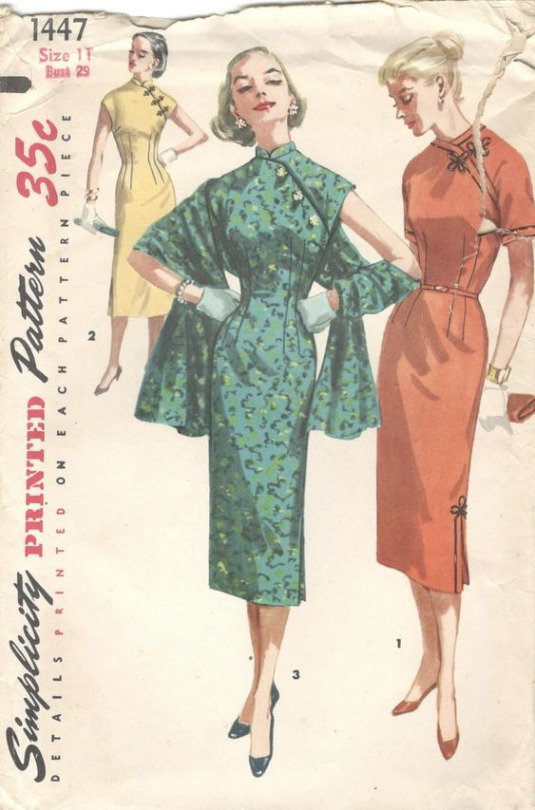
Source here
1950s Simplicity sewing pattern for cheongsam. Likewise with super low 1940s collars. Collarless cheongsam died in China in the mid 1920s, yet it lives on in the imagination of Western designers. By the way, the frog closures with a quatrefoil shape are not Chinese, I’m gonna write another post about this. I love the look in the middle it’s very glam.
1970s and later
The post 1960s era is what ultimately created the confusion around standing collars nowadays. Around this time Western and Chinese fashions started to merge and become one, and garments made completely in the historical Chinese method were more and more difficult to come by; Western construction techniques reigned supreme.
From the 70s onward, most “Chinese collars” had the 40s rounded edge shape but were either medium low or medium height. The lack of collar seam binding persisted into the current day, which is something I kind of lament because without this binding collars easily read as Renaissance doublet... (more on that later)
I usually avoid calling any standing collars from the 1970s onward Chinese/Mandarin because 1) standing collars were never a uniquely Chinese thing to begin with 2) since cheongsam was no longer fashionable among actual Chinese people, designers who made cheongsam pulled all kinds of shenanigans without any historical precedent whatsoever. Also, since clothes with structured/stiffened standing collars stopped being a staple in the average Western person’s wardrobe, white people started calling everything with the most remote hint of a standing collar Chinese to further stir the pot, emboldened by the cultural appropriation craze of the 60s and 70s. Ok that’s very loaded, but it’s true that in the 60s and 70s there was a lot of Western clothing designs that took inspiration from other cultures without permission. Westerners could totally design and wear Chinese style clothing given that the intention is respectful and they know about the garment in question, but a lot of times the accuracy of the designs leaves much to be desired. There was also a lot of Orientalist inspiration in the 10s and 20s but the borrowing back then wasn’t so... literal. When I look at so called cheongsam sewing patterns from the 70s onward, I sometimes seriously have trouble identifying if something is meant to be Chinese, Vietnamese, Japanese, Polynesian or any other region/culture...
I’ll just find pictures of Chinese inspired clothing from the 70s onward with a “Mandarin collar” label and point out their source of inspiration.
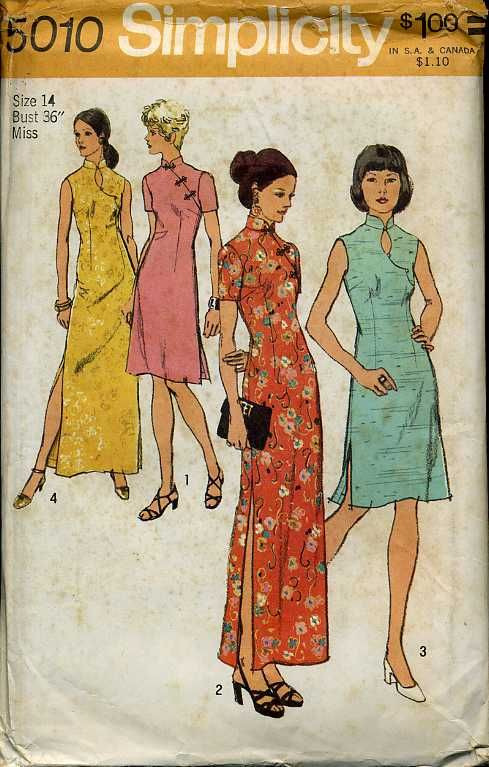
Source here
1972 Simplicity sewing pattern for cheongsam. It’s the same Western collar from the 50s and 60s just slightly taller. Oh and the closures used on the two designs in the middle are again likely not pankou. After the 60s, this neck design with a oval shape keyhole cutout became quite common and that persisted to the current day. Don’t know what the purpose of that was, just because you show 5 square centimeters more skin doesn’t mean your cheongsam is sexier?

Source here
The description of this 70s Simplicity pattern says “Mandarin collar” but the source of inspiration is obviously Japanese military/school uniforms, AGAIN. The collar’s height and rectangular edges, combined with the placement of buttons above the waist on the bodice, everything about this reads as Japanese. The frog closures on the left are once again European and not Chinese pankou (sheesh I really need to make this other post). The original designer probably meant for it to be Japanese but the seller mistakenly labelled it a Mandarin collar design.
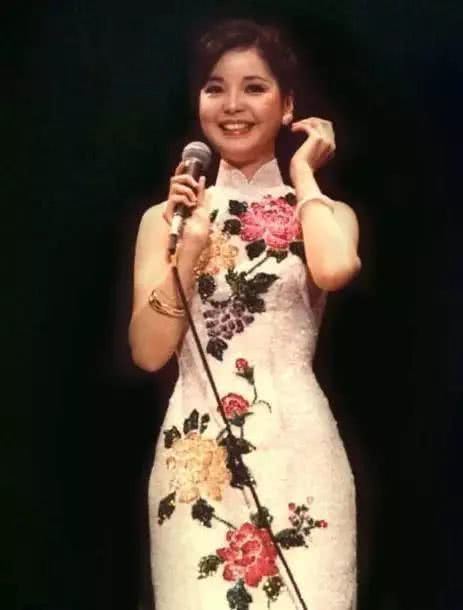
Source here
70s Teresa Teng (rest in power legend) in a theatrical cheongsam with a similar collar, either a stretched version of the 40s collar or a shrunk version of the 50s/60s one.
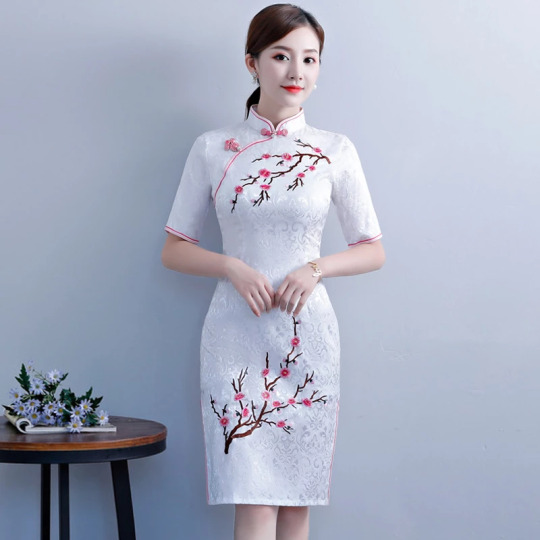
Source here
Google search result for “Mandarin collar dress”. Same Western low collar from the 70s. A new problem with modern mass produced cheongsam is that the collar oftentimes doesn’t fit the wearer and appears too baggy. Or maybe it’s not mass production, just that people nowadays are very unaccustomed to wearing tight fitting standing collars so they assume there needs to be some extra space? As someone who wears stiff standing collars on a regular basis I have to say it actually isn’t uncomfortable at all and elongates your neck a lot better. This is what most cheongsam collars nowadays look like, even the self proclaimed “traditional” ones, they literally originated from 1950s/60s Western sewing pattern companies’ interpretation of contemporary Chinese cheongsam collars.
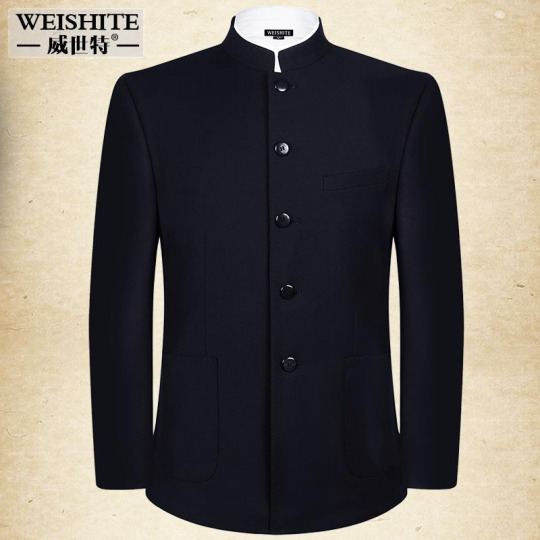
Source here
Baidu search result for “Mandarin collar suit”. This, is, literally, almost a replica Japanese uniform. The seller is also using the tag Zhongshan suit lmao (I’ve explained in my 1950s mainland post what a Zhongshan suit is not supposed to look like), delusion is not a fragrance I guess. Why is it so hard to let Japan be Japan and China be China??
Conclusion & afterthought
Another thing I need to mention is that standing collars are by no means unique to Chinese historical dress; they were also widely used in European historical fashion, long before standing collars became worn with uniforms of “Mandarins” or Chinese officials, which further proves my point that “Mandarin collar” is not a valid term. Also, standing collars in Europe have always been stiffened/structured, whereas Chinese collars only started to become stiffened around the 1890s, possibly due to European influence as well. For example, the 1950s collar with rounded edges and no collar seam binding reads as European Renaissance doublet very easily. To be fair though, a lot of the collar shapes seen in early 20th century Chinese womenswear had been done before in European Renaissance fashion and during that time period in China only the OG Ming Dynasty collar mentioned in part 1 was used sooooooo
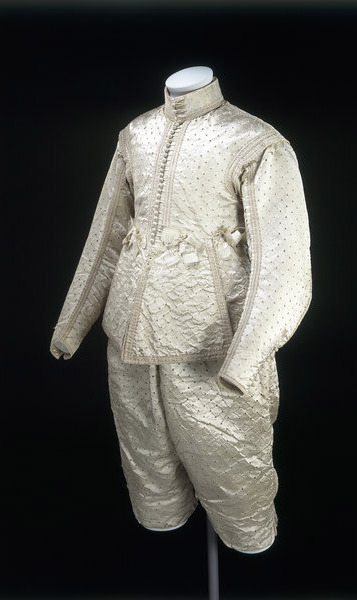
Source here
1630-40 English doublet. The collar looks mighty similar to 1930s Chinese women’s ones. I know next to nothing about Renaissance fashion so I’m not sure how it’s constructed, but it proves the point that collars like these were not a uniquely Chinese phenomenon.
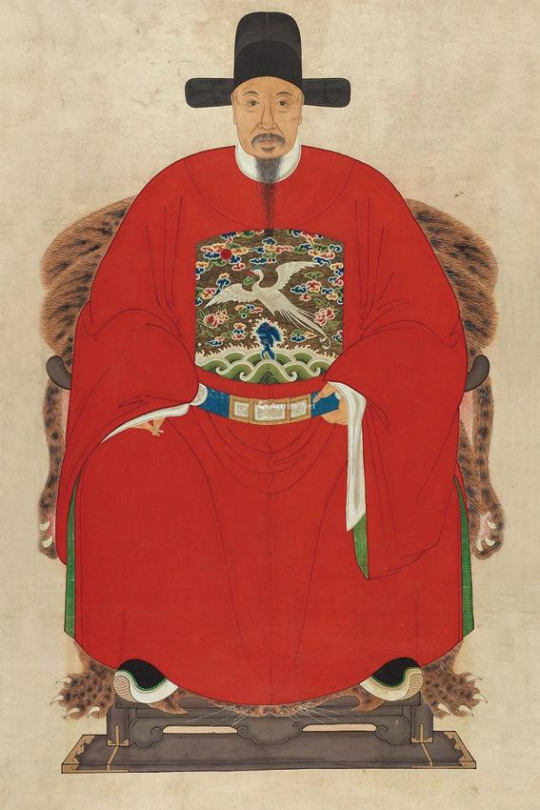
Source here
Meanwhile the Mandarins in China. He’s wearing a crossover collar robe underneath a round collar robe, no standing collar here.
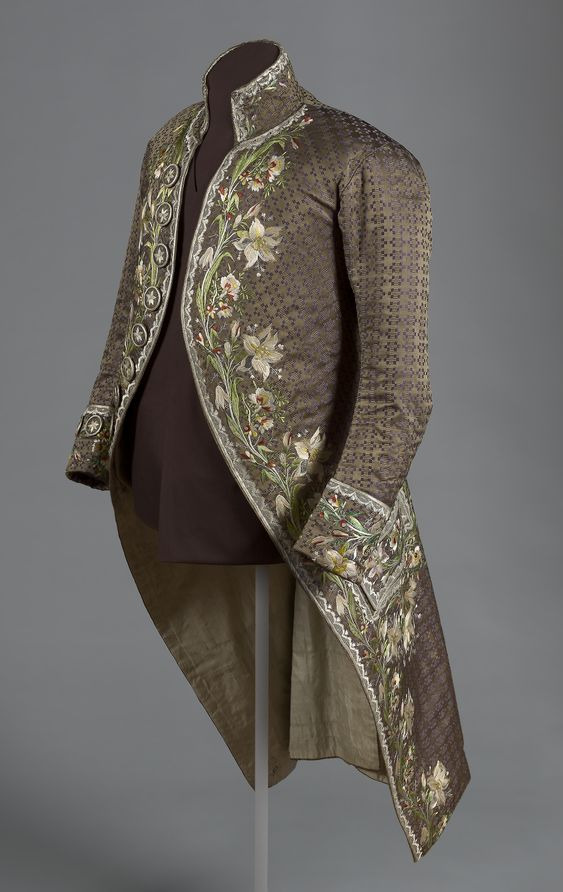
Source here
1780s French men’s coat with a standing collar.
Standing collars were also commonly used in Victorian and Edwardian women’s everyday fashion without any connection to China whatsoever.

Source here
1860s fashion plate for a gown with a low standing shirt collar peeking underneath.

Source here
1887 fashion plate from the Journal des Demoiselles. Bustle gowns with standing collars.
Bonus rant
I have come to the actual point of this series of posts, to answer the question: should “Mandarin collar” be a thing? In which case I’m gonna have to go with no. In the three posts I made on the topic I categorized a total of 13 collar styles, each distinct from each other and some being inspired by Western clothing, and showed that the use of the term “Mandarin collar” nowadays is very vague and ambiguous. I don’t understand why people in the fashion industry give my ancestors all the credits for a design feature as basic and common as a standing collar... Maybe it’s a marketing gimmick like how Sternhalma (a German board game) is advertised in the US as “Chinese checkers”?? Or maybe it shows that a lot of fashion designers lack a basic understanding of historical fashion? Either way it makes no sense. I think the concept is also slightly offensive since it simply ignores the diversity of actual historical Chinese standing collar designs, kind of reinforcing the racist stereotype that non-white fashion histories are static and never changing.
If I do have to pick a most traditional/iconic style of Chinese standing collar, I would go with either the original Ming Dynasty soft collar with metal buttons or the 1940s short collar with collar seam binding used on aoku, cheongsam, changshan and magua. In the mainland Chinese countryside, the 1940s style collar was preserved and actually still made today, but in the post-Mao era it became increasingly seen by the mainland population as 土 (a derogatory term for Chinese folk stuff meaning tacky or cringy) compared to the exciting new Western fashions being imported at the time. As a result, more traditional items of clothing like aoku for women, changshan and magua for men were neglected in favor of more westernized cheongsam designs, leading to some cursed contraptions.
Maybe this is a hot take, I personally really don’t vibe with the concept of 土 because it’s very loaded and usually the gateway drug to massive internalized racism. I’ve heard so many people bash aoku and magua constructed in the historical method and put post-60s Western inspired cheongsam on a pedestal even though the former is grounded in history and the latter is an Orientalist mess. There is nothing wrong with making aoqun, aoku, magua, changshan, cheongsam or any other historical item of clothing in the historically accurate method, they’re charming in their own ways and don’t need to be “modified”. In my opinion, the puckering under the armpits caused by the lack of a shoulder seam and the rounded shoulders are what makes historical Chinese clothing beautiful to begin with :3 I think there’s something inherently modern and authentic in the pedantic, antiquarian pursuit of historical clothing, like you know how whenever a revival happens it actually brings something new to the table? It’s not problematic to wear modern cheongsam designs per se, it’s just important to keep in mind that it doesn’t have much to do with actual Chinese history and represents more of the status quo of Chinese fashion nowadays.
Ok I’m going off the collar track but it’s time to finish this post. Thank you for reading, and as I mentioned, the next post will be about Chinese pankou. I’m almost finished with that one as well and I’m really excited with what I have planned next :D
195 notes
·
View notes
Note
People think Emilie and Gabriel found miraculous when they were adults but this is impossible because Gabriel has been a famous fashion designer for a long time and a butterfly with the logo of Gabriel's brand . Thomas Astruc says we will see the relationship between Emilie and Gabriel and I think should be linked to these events . I think Emilie and Gabriel found miraculous as teen not married adults , I think we're going to watch teen Gabriel and Emilie find miraculous . What do you think ?
Thank you so much for this fantastic question, this is one of my favorite miraculous topics to theories about! I just wish I could give you a solid answer to that. But I’ll glady tell you my thoughts on it! I apologize beforehand if this turns out real long (which it probably will)
Well the whole Agreste-Miraculous-backstory is still very much in the blur to this point but I agree this much with you that Emilie and Gabriel MUST have had the peacock for longer than we initially thought. In the originis episodes it pretty much seems like Gabriel was using the butterfly for the very first time. Nooroo didnt know him yet and Gabriel commanded him to tell him about the butterflys powers. So I believe the butterfly and the miraculous book were indeed found by Gabriel and Emilie on their last journey to Tibet since gabriel said in “the colllector” to Marinette that it was Emilies very last gift to him from that very journey (and this show wouldnt have included that line if it wasnt true. That was staright backstory information for the viewer)
BUT the peacock miraculous was found earlier and if I’m right the show already gave us some clues in the very same episode I just mentioned. Remember this in the collector?”


This old drawing from Adrien was shown for an other reason than just highlighting Gabriels ruthlessness and Adriens sorrow. Look at the picture closely

You see the mountains in the background? Good. Now let me tell you something about Tibet and things might get clearer.
Tibet is a highland in central Asia and in my country (germany) it’s even called “The roof of the world” because its one of the or even THE highest place on earth (fun fact, thats also where Mount Everest is). This is highly interesting and suspicious when you remember that the miraculous lore in general is very Chinese/Asian oriented and THIS

is the location we were given were master fu lost the peacock,butterfly and book. (look at the background, thats one HELL of a high place! They are above the CLOUDS)
So the mountains in the background of Adriens old family vacation drawing? I bet my left arm thats Tibet and the time the peacock was found. The show decided to give us both the drawing and Fus backstory in the same episode, we were supposed to connect something there. I’m not entirely sure how “intentional” the search was since Adrien was brought along but I’m certain the first “founding” was there. There is no other reason they would include mountains into the picture after visually revealing some of Fus story. It could have been anything else that isnt so especific but they chose this setting and “Miraculous” doesnt introduces or hints at loations they are not gonna use one day properly.
Them finding the peacock around 10 years ago (I’m guessing Adrien to be 4-5 years old in the drawing. Its a typical drawing style for a kindrgartner in Tv-shows/movies) also can explain why Gabriel knows so much about these two miraculouses and why hes so much more experienced in using and holding his powers than LB and CN even though he started using his on the same day as they did.

The new webepisode “Gabriel” also comfirmed that Emilie DID indeed use the peacock prior to the show (and thats why shes in a coma now)

And from the way Gbriel reacted to Mayuras help we can definitly tell that Gabriel has witnessed/ exerienced in himself how the (damaged) peacocks powers work and that consequences come out of using it


I can not present you an answer to what Emilie did with the peacock with a clear conscious (I’m having an idea though. But for now I’ll say it couldnt have been anything publicly), but I’m convinced Emilie used and learned alot about the peacock and that Gabriel was IN in all of this and supported her. Thats how he got so experienced and knowledgeable, though Emilie!
But to come back to the beginning and summing up my answer to one of your points: No I dont think they were teenangers when they found the 3 lost miraculou objects, they were adults.
BUT you are again making a fantastic point with the butterfly being Gabriels logo for who knows how long! Because that is 100% true and certainly no convincedense (as if). Alright, lets break this down too!
For this I need to say that I strongly believe that, basically, it was Emilie who accidentally started all of this. The show portrays her as the missing link to the Agreste-Mystery/Drama/Backstory and she wouldnt have been taken out of the picture for now or presented to us like that if she wasnt an important key character with critical knowledge to the story. But I digress. As stated before, Gabriel verly likely learned everything he knows about the miraculouses from HER so she had to have been the one who learned about it first. Meaning, I think Emilie was a Miracuous enthusiast since she was younger (possibly teenager/young adult as you said) and got a little.. well, a little obsessed? In the in-universe world the miraculous have heavily influenced the history of earth for who knows how long already. So many heros and villains were made by them, so I dont thing I’m reaching at all when I say that I’m sure that at this point, they have become legends and myths (“The Pharao” basically comfirms this with the puplicly historical evidences of the past Ladybugs). So yeah, I think Emilie really got into this miraculous mythology (I have a suspicion how, but I need more details first before I’m confident to state and stant to it. Just know, I have a solid reason in mind when I tell you this). And Gabriel who fell in love with her, supported her in her interest and odd hobby (probably couldnt even have imagined how big this “hobby” would become tho). This is how I think Gabriel ended up with the butterfly as his logo. Out of love for her (which in THIS show is VERY likely) he dedicated his fashion labels sigiture sign to his wifes interest (which also fits to the name “Agreste” which literally can be translated to “butterfly”, so smart move there Gabe), also it seems like Emilie had a special interest in the butterfly because “the collector” God I love this episode shows us how Adrien realised that the mansion is full of hidden butterflies and the show wouldnt present that as something bad if it didnt had a deeper meaning.
What I didnt state above because it fits better here is that, on the vacation from Adriens drawing and where they likely found the peacock, I think Emilie knew it could/would be there. I just find it highly unlikely that they just found a miraculous on their family vacation that Emilie has been obsesion over for so long, in the highlands of Tibet. Like, how random and Anticlimactic would that be?
No, I think she knew. Emilie might have figured out that the Miracuouses should be there, so they went to Tibet to find them. Though I’m honestly thinking that finding them was Emilies secret side project and she didnt tell Gabriel about her other intentions there. Because I dont see why else a 4 years old Adrien should have been brought along, if it wasnt planned as a simple “family vacation” to Tibet.
Alright I’m gonna stop here, I hope you didnt mind my text wall xD
45 notes
·
View notes
Text
Avatar: Cultural Appreciation or Appropriation?
I love Avatar: the Last Airbender. Obviously I do, because I run a fan blog on it. But make no mistake: it is a show built upon cultural appropriation. And you know what? For the longest time, as an Asian-American kid, I never saw it that way.
There are plenty of reasons why I never realized this as a kid, but I’ve narrowed it down to a few reasons. One is that I was desperate to watch a show with characters that looked like me in it that wasn’t anime (nothing wrong with anime, it’s just not my thing). Another is that I am East Asian (I have Taiwanese and Korean ancestry) and in general, despite being the outward “bad guys”, the East Asian cultural aspects of Avatar are respected far more than South Asian, Middle Eastern, and other influences. A third is that it’s easy to dismiss the negative parts of a show you really like, so I kind of ignored the issue for a while. I’m going to explain my own perspective on these reasons, and why I think we need to have a nuanced discussion about it.
Obviously, the leadership behind ATLA was mostly white. We all know the co-creators Bryan Konietzko and Michael Dante DiMartino (colloquially known as Bryke) are white. So were most of the other episodic directors and writers, like Aaron Ehasz, Lauren Montgomery, and Joaquim Dos Santos. This does not mean they were unable to treat Asian cultures with respect, and I honestly do believe that they tried their best! But it does mean they have certain blinders, certain perceptions of what is interesting and enjoyable to watch. Avatar was applauded in its time for being based mostly on Asian and Native American cultures, but one has to wonder: how much of that choice was based on actual respect for these people, and how much was based on what they considered to be “interesting”, “quirky”, or “exotic”?
The aesthetic of the show, with its bending styles based on various martial arts forms, written language all in Chinese text, and characters all decked out in the latest Han dynasty fashions, is obviously directly derivative of Asian cultures. Fine. That’s great! They hired real martial artists to copy the bending styles accurately, had an actual Chinese calligrapher do all the lettering, and clearly did their research on what clothing, hair, and makeup looked like. The animation studios were in South Korea, so Korean animators were the ones who did the work. Overall, this is looking more like appreciation for a beautiful culture, and that’s exactly what we want in a rapidly diversifying world of media.
But there’s always going to be some cherry-picking, because it’s inevitable. What’s easy to animate, what appeals to modern American audiences, and what is practical for the world all come to mind as reasons. It’s just that… they kinda lump cultures together weirdly. Song from Book 2 (that girl whose ostrich-horse Zuko steals) wears a hanbok, a traditionally Korean outfit. It’s immediately recognizable as a hanbok, and these dresses are exclusive to Korea. Are we meant to assume that this little corner of the mostly Chinese Earth Kingdom is Korea? Because otherwise, it’s just treated as another little corner of the Earth Kingdom. Korea isn’t part of China. It’s its own country with its own culture, history, and language. Other aspects of Korean culture are ignored, possibly because there wasn’t time for it, but also probably because the creators thought the hanbok was cute and therefore they could just stick it in somewhere. But this is a pretty minor issue in the grand scheme of things (super minor, compared to some other things which I will discuss later on).
It’s not the lack of research that’s the issue. It’s not even the lack of consideration. But any Asian-American can tell you: it’s all too easy for the Asian kids to get lumped together, to become pan-Asian. To become the equivalent of the Earth Kingdom, a mass of Asians without specific borders or national identities. It’s just sort of uncomfortable for someone with that experience to watch a show that does that and then gets praised for being so sensitive about it. I don’t want you to think I’m from China or Vietnam or Japan; not because there’s anything wrong with them, but because I’m not! How would a French person like to be called British? It would really piss them off. Yet this happens all the time to Asian-Americans and we are expected to go along with it. And… we kind of do, because we’ve been taught to.
1. Growing Up Asian-American
I grew up in the early to mid-2000s, the era of High School Musical and Hannah Montana and iCarly, the era of Spongebob and The Amazing World of Gumball and Fairly Odd Parents. So I didn’t really see a ton of Asian characters onscreen in popular shows (not anime) that I could talk about with my white friends at school. One exception I recall was London from Suite Life, who was hardly a role model and was mostly played up for laughs more than actual nuance. Shows for adults weren’t exactly up to par back then either, with characters like the painfully stereotypical Raj from Big Bang Theory being one of the era that comes to mind.
So I was so grateful, so happy, to see characters that looked like me in Avatar when I first watched it. Look! I could dress up as Azula for Halloween and not Mulan for the third time! Nice! I didn’t question it. These were Asian characters who actually looked Asian and did cool stuff like shoot fireballs and throw knives and were allowed to have depth and character development. This was the first reason why I never questioned this cultural appropriation. I was simply happy to get any representation at all. This is not the same for others, though.
2. My Own Biases
Obviously, one can only truly speak for what they experience in their own life. I am East Asian and that is arguably the only culture that is treated with great depth in Avatar.
I don’t speak for South Asians, but I’ve certainly seen many people criticize Guru Pathik, the only character who is explicitly South Asian (and rightly so. He’s a stereotype played up for laughs and the whole thing with chakras is in my opinion one of the biggest plotholes in the show). They’ve also discussed how Avatar: The Last Airbender lifts heavily from Hinduism (with chakras, the word Avatar itself, and the Eye of Shiva used by Combustion Man to blow things up). Others have expressed how they feel the sandbenders, who are portrayed as immoral thieves who deviously kidnap Appa for money, are a direct insult to Middle Eastern and North African cultures. People have noted that it makes no sense that a culture based on Inuit and other Native groups like the Water Tribe would become industrialized as they did in the North & South comics, since these are people that historically (and in modern day!) opposed extreme industrialization. The Air Nomads, based on the Tibetan people, are weirdly homogeneous in their Buddhist-inspired orange robes and hyperspiritual lifestyle. So too have Southeast Asians commented on the Foggy Swamp characters, whose lifestyles are made fun of as being dirty and somehow inferior. The list goes on.
These things, unlike the elaborate and highly researched elements of East Asian culture, were not treated with respect and are therefore cultural appropriation. As a kid, I had the privilege of not noticing these things. Now I do.
White privilege is real, but every person has privileges of some kind, and in this case, I was in the wrong for not realizing that. Yes, I was a kid; but it took a long time for me to see that not everyone’s culture was respected the way mine was. They weren’t considered *aesthetic* enough, and therefore weren’t worth researching and accurately portraying to the creators. It’s easy for a lot of East Asians to argue, “No! I’ve experienced racism! I’m not privileged!” News flash: I’ve experienced racism too. But I’ve also experienced privilege. If white people can take their privilege for granted, so too can other races. Shocking, I know. And I know now how my privilege blinded me to the fact that not everybody felt the same euphoria I did seeing characters that looked like them onscreen. Not if they were a narrow and offensive portrayal of their race. There are enough good-guy Asian characters that Fire Lord Ozai is allowed to be evil; but can you imagine if he was the only one?
3. What It Does Right
This is sounding really down on Avatar, which I don’t want to do. It’s a great show with a lot of fantastic themes that don’t show up a lot in kids’ media. It isn’t superficial or sugarcoating in its portrayal of the impacts of war, imperialism, colonialism, disability, and sexism, just to name a few. There are characters like Katara, a brown girl allowed to get angry but is not defined by it. There are characters like Aang, who is the complete opposite of toxic masculinity. There are characters like Toph, who is widely known as a great example of how to write a disabled character.
But all of these good things sort of masked the issues with the show. It’s easy to sweep an issue under the rug when there’s so many great things to stack on top and keep it down. Alternatively, one little problem in a show seems to make-or-break media for some people. Cancel culture is the most obvious example of this gone too far. Celebrity says one ignorant thing? Boom, cancelled. But… kind of not really, and also, they’re now terrified of saying anything at all because their apologies are mocked and their future decisions are scrutinized. It encourages a closed system of creators writing only what they know for fear of straying too far out of their lane. Avatar does do a lot of great things, and I think it would be silly and immature to say that its cultural appropriation invalidates all of these things. At the same time, this issue is an issue that should be addressed. Criticizing one part of the show doesn’t mean that the other parts of it aren’t good, or that you shouldn’t be a fan.
If Avatar’s cultural appropriation does make you uncomfortable enough to stop watching, go for it. Stop watching. No single show appeals to every single person. At the same time, if you’re a massive fan, take a sec (honestly, if you’ve made it this far, you’ve taken many secs) to check your own privilege, and think about how the blurred line between cultural appreciation (of East Asia) and appropriation (basically everybody else) formed. Is it because we as viewers were also captivated by the aesthetic and overall story, and so forgive the more problematic aspects? Is it because we’ve been conditioned so fully into never expecting rep that when we get it, we cling to it?
I’m no media critic or expert on race, cultural appropriation, or anything of the sort. I’m just an Asian-American teenager who hopes that her own opinion can be put out there into the world, and maybe resonate with someone else. I hope that it’s given you new insight into why Avatar: The Last Airbender is a show with both cultural appropriation and appreciation, and why these things coexist. Thank you for reading!
#reposting this without the cut so that it survives with my new url!#avatar#avatar the last airbender#atla#cultural appropriation#culture#atla crit#meta#criticism#racism tw#self rb#citrina writes
80 notes
·
View notes
Text
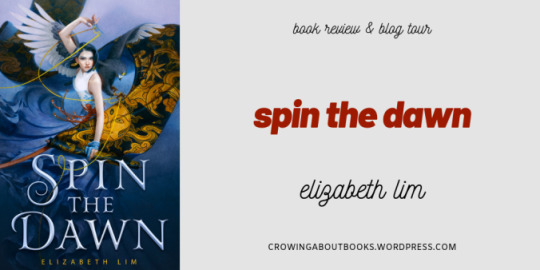
Spin the Dawn by Elizabeth Lim
July 9, 2019, from Knopf Books for Young Readers
Young adult fantasy
Goodreads | Amazon | Book Depository
Project Runway meets Mulan in this sweeping YA fantasy about a young girl who poses as a boy to compete for the role of imperial tailor and embarks on an impossible journey to sew three magic dresses, from the sun, the moon, and the stars.
Maia Tamarin dreams of becoming the greatest tailor in the land, but as a girl, the best she can hope for is to marry well. When a royal messenger summons her ailing father, once a tailor of renown, to court, Maia poses as a boy and takes his place. She knows her life is forfeit if her secret is discovered, but she’ll take that risk to achieve her dream and save her family from ruin. There’s just one catch: Maia is one of twelve tailors vying for the job.
Backstabbing and lies run rampant as the tailors compete in challenges to prove their artistry and skill. Maia’s task is further complicated when she draws the attention of the court magician, Edan, whose piercing eyes seem to see straight through her disguise.
And nothing could have prepared her for the final challenge: to sew three magic gowns for the emperor’s reluctant bride-to-be, from the laughter of the sun, the tears of the moon, and the blood of stars. With this impossible task before her, she embarks on a journey to the far reaches of the kingdom, seeking the sun, the moon, and the stars, and finding more than she ever could have imagined.
Steeped in Chinese culture, sizzling with forbidden romance, and shimmering with magic, this young adult fantasy is pitch-perfect for fans of Sarah J. Maas or Renée Ahdieh.
Hi folks! I’m so grateful to be able to be a part of the blog tour for Elizabeth’s Spin the Dawn, an incredibly creative and vivid Asian-inspired fantasy. Thank you so much to Shealea and Caffiene Book Tours for giving me this opportunity! I’m very excited to share my review and some aesthetics and quotes today.
There’s an aspect in high fantasy worldbuilding that doesn’t, in my opinion, get due credit, and that’s the fashion and clothing of the world. I love historical fashion, but most books tend to skim over the clothes that bring life to the world and characters. Spin the Dawn turns it into an epic story filled with action, romance, and amazing worldbuilding.
Our heroine is Maia Tamarin, a skilled tailor who takes her brother’s place in a competition to become the new imperial tailor. I very much adored Maia’s character and love that we don’t see your typical fantasy protagonist here. Maia is not a fighter; she can get by when she needs to, but she’s not good at it. Rather, her talent lies in tailoring: knitting, sewing, embroidering, and it’s exactly what she needs to excel in the world she lives in. Maia is headstrong, determined, and incredibly dedicated to her craft, and it’s clear that she’s a true expert–magical scissors or not. Maia has also been through a lot in her lifetime: she’s lost her mother and two of her brothers while the rest of her family is also shattered from the lost, and even though she’s learned to heal from it to some extent, her experience is something that colours her narrative and character arc. It gives her the drive she needs to take care of her family and pour all her energy into succeeding.
Of all the other characters, Edan really stands out: he was so sweet all the time, with a lot of mystery and a great sense of humour. Honestly, a standup guy all around and an absolutely loveable love interest. Unlike a lot of relationships between immortals and teenagers, this one only weirded me out a bit (the Darkling who? I only know Edan). I also loved the slow burn component to the romance; their romance subplot didn’t feel too dragged out or too quick. And one character who we didn’t learn a whole lot about but who absolutely intrigues me is Emperor Khanujin, who despite being relatively young for an emperor has put his kingdom through a war. It certainly looks like there’s a lot more to him than the surface shows, and I hope Maia (and us!) get to find out more about him in the next book.
The land of A’landi was also fascinating and in many ways timeless, taking inspiration from all parts of China and other Asian cultures to create A’landi. I’m not sure if A’landi is meant to be a counterpart of China or not, but it definitely reads more like a cultural fusion of Asian cultures than only China–from the descriptions of the food, to names, people, and fashions. Nevertheless, I did enjoy it: the world of Spin the Dawn is one of the most vivid and realized fantasy worlds I’ve read in a while, and I loved seeing all of the different environments and places of A’landi.
Elizabeth Lim’s writing is so lyrical and gorgeous and truly a pleasure to read. In terms of pacing, I felt as if it was mostly done right–there are two different sections to the book that have two very different tones and plots. However, I don’t think either would have been able to constitute a book on its own. I also feel as if the final part of the book was a bit rushed–but hopefully, this is something that I’ll feel better about after I read the sequel (which I am very excited for).
I very much enjoyed reading Spin the Dawn: it’s a rare bit of fantasy that doesn’t focus on physical trials and protagonists who know how to fight, but it’s still packed with action and adventure. The loveable characters and wonderfully crafted world will certainly leave readers wanting more.

aesthetics + giveaway!!
We also have a giveaway going on! You can enter to win a copy of Spin the Dawn at this link, and good news, it’s INTERNATIONAL!!
(Ya girl loves international giveaways.)
We also have a Twitter chat happening at 9pm Phillipines time–which is 9am EST and 6am PST. There will be a giveaway for US-based participants, so if you’re in the US, set your alarms.
You can also check out the rest of the tour schedule here!

about the author
Elizabeth Lim grew up on a hearty staple of fairy tales, myths, and songs. Her passion for storytelling began around age 10, when she started writing fanfics for Sailor Moon, Sweet Valley, and Star Wars, and posted them online to discover, “Wow, people actually read my stuff. And that’s kinda cool!” But after one of her teachers told her she had “too much voice” in her essays, Elizabeth took a break from creative writing to focus on not flunking English.
Over the years, Elizabeth became a film and video game composer, and even went so far as to get a doctorate in music composition. But she always missed writing, and turned to penning stories when she needed a breather from grad school. One day, she decided to write and finish a novel — for kicks, at first, then things became serious — and she hasn’t looked back since.
Elizabeth loves classic film scores, books with a good romance, food (she currently has a soft spot for arepas and Ethiopian food), the color turquoise, overcast skies, English muffins, cycling, and baking. She lives in New York City with her husband.
Website | Goodreads | Instagram | Facebook | Twitter

what are your favourite mulan retellings, or favourite asian fantasies?? will you be reading spin the dawn when it comes out??

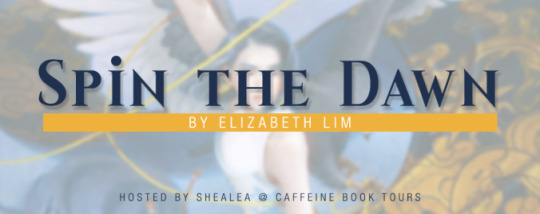
hi folks i am SO grateful to be able to be a part of the blog tour for SPIN THE DAWN by @lizlim! thank you to @caffienetours @shutupshealea for hosting, this was a wonderful experience & book!! #SpinTheDawnTour Spin the Dawn by Elizabeth Lim July 9, 2019, from Knopf Books for Young Readers Young adult fantasy…
4 notes
·
View notes
Text
One of the tasks on my Great Decluttering To Do List was to update The Big List of Restaurants&alia™ and effectively get rid of Zomato - the app I used in the past two years to track the places I went to and the ones I wanted to go to. While it has great interface for the restaurants pages – featuring pics, menus, location – the UX design is poor and sorting through one’s bookmarks is difficult (even though enabling self-tagging and self-sorting wouldn’t be so hard). It just doesn’t work for me, so a few months ago I switched to an old-fashioned list, which has many perks: most importantly I am able to divide it into as many categories as I want (which are…. a lot. e.g. there are two different ones for pizzerias), which turns out to be infinitely helpful in the process of deciding where to go.
Anyway
The List is long, since its purpose is to always provide an option.
I never expected to try all the places, partially because I don’t eat out often, partially because when I do it’s incidental – e.g. in between a study sesh at the library – so there’s a time and location constraint.
However, to my surprise I have been to 45 different places in Milan (i.e. returning to the same place didn’t count), excluding fast food chains (McDonald’s, KFC, Burger King). Which honestly? It’s way more than I would have imagined.
And since statistics is fun and informative, I decided to look closer at the data and make a spreadsheet. Here’s what it shows:
As predicted, the great majority of places I went to is either in Porta Venezia or Bocconi. Behind by 10 percentage points there’s the whole Duomo/San Babila area which is where I typically see my best friend since it’s close to her university and my flat. When I venture in places outside my everyday zone is always for dinner, which makes sense.
Broadly speaking, I split my outings among “lunch”, “dinner” and “other” quite equally. However, a closer look by splitting up dinner and aperitivo and considering that “other” means either breakfast/brunch/coffee or snack/tea, lunch is by far the most popular time of the day.
As for correlation, tourist-y and/or hyped, often “landmarks”, places are more likely to be bad and less likely to be great (no surprise here). The historical trend is that I’m visiting these places less and less.
Generally, out of the 45, I liked 61% of them but only 17% where truly great i.e. I would recommend them in a heartbeat, I have gone back multiple times, I wholeheartedly loved it
I suspected this, but seeing the result was still a bit surprising – I picked the place only 37% of the times while 63% someone else made the suggestion. Specifically, when I go out with people from my university, I let them decide. When I go out with best friend #1, she almost always decides (90% of the times), while with best friend #2 I always end up deciding. (And if it’s us three, it’s still bf#1 who decides). Generally, the process is very democratic, in the end the place was okay with all three of us, but, especially as of late, it has been irking me that her no is final and we always have to pick from her options. And it’s a recent trend, because in the beginning it was way more even, while nowadays she almost never takes suggestions outside her list of options. Note to self: be more assertive. There’s also a third person I have often dinner with and the decision is typically evenly split; anyone else is not significant.
Did I spend about an hour organizing the list and making detailed charts for this? Yes. Was it useful? Doubtfully.
In more concrete terms, the next academic year will hopefully be my last one in Milan (probably not but right now I can afford to hope) so I compiled a small list of places I absolutely want to go to:
Either of the two bubbletea places that are on my way to university
Slow Sud
At least one place that makes Ramen
Coffeeshops and teashops: Clotilde Bistrot, Riad, Cocotte
One of the many seemingly delicious Chinese places next to my flat
Ravioleria Sarpi
Places with food I have never tried before: Matcha Café (matcha coffee obvs), Maido (okonomiyaki), Temakinho (sushi with a twist)
Dry (pizza)
16 notes
·
View notes
Note
honestly if u got good gay movie recs... i would totally appreciate them! i’ve seen most of the popular good ones but i’d love to hear abt more
Just in case you or other people have missed one of the more popular ones, I want to start by saying But I’m a Cheerleader is my favorite and is at the top of most lesbian movie lists for a good reason. A lot of other lists have included the movies Imagine Me & You, Carol, and The Handmaiden, which are also all great. Almost everyone has heard of Blue is the Warmest Color, which I’ve only seen once a long time ago but would not recommend because of the way the director treated the actresses especially during the filming of the sex scene.
Anyways this list became more detailed than I originally intended so I’m just gonna put my recs below the cut lol
Movies that aren’t sad (or are only partially sad):
Desert Hearts (1985) - one of the first (if not the first) movies about a romantic relationship between women that doesn’t end in one or both of them dying or leaving the other to be with a man. Directed by Donna Deitch who is gay.
D.E.B.S. (2004) - probably the most fun/light hearted movie I’ve seen that’s centered around a romance between two women. It’s a cheesy movie about a spy who falls in love with a villain and is written and directed by Angela Robinson who is bi.
The Incredibly True Adventure of Two Girls In Love (1995) - cute and kinda cheesy teen rom com written and directed by Maria Maggenti who is bi.
The Watermelon Woman (1996) - a lesbian filmmaker works on a documentary about a black actress from the 1930s. The film explores themes of how there are gaps in recorded history, and how race effects relationships. It was written and directed by Cheryl Dunye, making it the first (known/more popular) feature film directed by a black lesbian.
If These Walls Could Talk 2 (2000) - explores the lives of three lesbian couples who happened to live in the same house at different periods of time. The first part takes place in 1961 and is sad, the second part takes place in 1972 and is the part all those butch Chloe Sevigny gifs are from, and the last part takes place in 2000 and stars Ellen.
Saving Face (2004) - super cute and good rom com about a Chinese American lesbian and her traditionalist mother written and directed by Alice Wu who is a lesbian.
The Runaways (2010) - if ur gay for rock n roll please watch this. I love bicon Joan Jett
Cloudburst (2011) - about an older lesbian couple who go on a road trip to get married and the ending is kind of sad but it’s worth watching imo.
Pariah (2011) - about a butch lesbian teenager growing up in Brooklyn. It’s really sad in some parts but by the end she’s very at peace with herself. Written and directed by Dee Rees who is a lesbian.
Life Partners (2014) - cute movie about the friendship between a straight woman and a lesbian and how their friendship changes when the straight woman gets married
Boy Meets Girl (2015) - about a bisexual trans girl (played by a trans actress) who wants to go to college be a fashion designerGrandma (2015) - Lily Tomlin plays a lesbian grandma who helps her granddaughter get money to have an abortion
Dope (2015) - tbh the lesbian isn’t even the main character, but it’s a cute movie and Kiersey Clemons is hot so it’s on here anyway
The Intervention (2016) - Clea DuVall and Natasha Lyonne play a couple again, Melanie Lynskey and Alia Shawkat are also in it. Written and directed by Clea DuVall who is a lesbianProfessor Marston and the Wonder Women (2017) - probably not super historically accurate tbh but it’s about the polyamorous relationship between the creator of Wonder Woman, his wife, and their lover. I was pleasantly surprised that the movie focused just as much if not more on the relationship between the two women as it did on their relationship to the man. It is written and directed by Angela Robinson, a bi woman.
Battle of the Sexes (2017) - I know people on here don’t like Emma Stone but Billie Jean King is cool as fuck, the scenes between her and Marilyn were beautiful, and this movie was underrated
Movies that are pretty sad throughout but good:
Fried Green Tomatoes (1991) - not as gay as the book and the ending (and other parts) are sad, but I would die for the main character (and butch icon) Idgie.
Lovesong (2016) - two women are probably in love with each other go on a road trip but one of them is getting married to a man :( the other one is played by Jenna Malone though who I’ve been wanting to play gay since she played Johanna in the Hunger Games so :) ?
Novitiate (2017) - lesbian nuns, Catholic guilt, idk it’s good though
Movies that didn’t necessarily fit into the other categories because they are either intense, weird, and/or involve murder:
Born in Flames (1983) - I wasn’t really sure what category to put this movie in since its style is so different from the others, but it’s about activists fighting for women’s liberation in a fictional version of the US where there has been a socialist revolution that promised to make things better, but put off women’s rights in the process. Anyone interested in feminism and leftist politics should check it out. It was made by Lizzie Borden, who is bisexual.
Heavenly Creatures (1994) - a movie about a super intense childhood friendship that gets pretty dark, which I know it’s a trope, but I liked this movie anyway idk
Mulholland Drive (2001) - the most real thing in this movie about surrealist Hollywood was the relationship between the two women
Monster (2003) - based on the life of serial killer Aileen Wuornos. It’s super violent/depressing/disturbing, but worth the watch imo. Directed by Patty Jenkins who directed Wonder Woman.
Jennifer’s Body (2009) - some people like to argue over whether they were actually gay or not but like…they were…it was also directed and written by women.
Addicted to Fresno (2015) - two sisters accidentally murder someone and try to cover it up. Written by Karey Dornetto who is gay and directed by Jamie Babbit who is a lesbian and also wrote/directed But I’m a Cheerleader.
Women Who Kill (2016) - about exes who are true crime podcasters. One of them starts dating someone and the other thinks her new girlfriend might be a murderer. Super interesting and can be interpreted as a metaphor for internalized homophobia. Written and directed by Ingrid Jungermann who is gay.
Atomic Blonde (2017) - bisexual spy Charlize Theron. I am gay. It falls into some bad tropes but I. Am. Gay.
Thelma (2017) - a Norwegian movie about a lesbian with supernatural abilities. It might be my favorite movie of 2017 tbh.
Documentaries:
Out in the Night (2014) - a really depressing and frustrating doc about a group of black lesbians who were unfairly imprisoned after fighting back against their attacker
Gender Troubles: The Butches (2016) - a doc about butches and gender presentation
Movies that are coming out soon that I wanna see:
Colette
Duck Butter
Hearts Beat Loud
Lizzie
The Miseducation of Cameron Post
Tully
Vita and Virginia
Wild Nights With Emily
84 notes
·
View notes
Text
Domestic Bliss Ask - Hana x Persephone

@kennaxval asked me to do a Domestic Bliss headcanon for Hana and my OC Persephone, so I thought I’d introduce her here before I plunged in. Persephone is Penelope’s much-older and very bossy sister, who currently lives in Paris and meets Hana when she returns to Cordonia for work purposes.
I have an NSFW ask to be done at a later point, requested by an anonymous poster, which will take a little more time. I’m still trying to figure out for certain what their sexual relationship looks like.
Who first brings up moving in together?
Hana, when she proposes (yep, she does the proposing, and no one quite believes either of them when they tell this story to people) just before Persy is scheduled to go back to Paris. Persy doesn’t give her a straight answer at first and leaves, and Hana believes she doesn’t want a steady relationship, but she returns eventually - for good - and accepts.
Their first few months as a couple are pretty much split between Valtoria and Portavira (Persy and Penelope’s parents’ estate). But once Hana’s best friend Esther marries King Liam and moves to the palace, Persy moves base to Valtoria, eventually working on her immensely successful fashion-and-lifestyle blog from there.
What is their morning routine?
Hana wakes up earlier. Persy’s definitely the night owl of the two. Even on days when she doesn’t have something to do, it usually takes her a while to go to sleep. Hana on the other hand sleeps as soon as she gets into bed, and loves to do something creative before Persy gets up - some days it’s embroidery, some days it’s playing the piano. Hana usually gets breakfast ready, but Persy insists on taking over during the weekends.
What is their nighttime routine?
Nighttime is Hana’s reading time, and on the nights Persy is free, it’s one of the few routines she picks up from Hana. Hana is very old-school - she can’t imagine reading without turning over pages, without the smell of old paper, the way it feels beneath her fingertips. Persy uses her Kindle (blasphemy!).
Occasionally they’ll stop to read aloud passages that stand out to them, passages that remind them of each other or sound inspiring. Persy tends to read out passages from her favourite book Women Who Run With the Wolves, a book she’d love to see Hana read.
Hana misses home, sometimes, so she thumbs through an old collection of classical Chinese poetry (her favourite being the poems of the Song Dynasty) that she had secretly bought as a young adult, and reads out verses. Her favourite is “The Night of the Lantern Festival”: she says it reminds her of Persy.
Who takes long showers/baths?
Definitely Hana. She’s a complete water girl, loves the feel of water on her skin, and will never pass up the opportunity to enjoy a shower for as long as she humanely can.
Persy likes being quick and efficient in all things, so it’s just “get in, get clean, get out”.
Who cooks, and who sets the smoke alarm off?
The more elaborate, family-style cooking? No one can do it like Hana can. Cooking is a stress buster for her. It’s what calms her down when she’s upset or worried. When Persy is around she will happily take over the cooking completely. Because if it were really up to Persy, they’d have minor variations of the five dishes she knows, every week. (“Good God Hana stop behaving like my mother. You’d think there was an entire army living in this house, not two people”)
Had Persy not fled from Cordonia during Leo’s social season…or been pushed into making a life for herself, she would have probably ended up like her “I can’t even boil water!” sister. Persy’s first few months in Paris were hard because she knew absolutely nothing - not how to cook, not how to buy supplies, not how to store food. She had to start over from scratch, and learn at least a few simple recipes - and those recipes have carried her over the past 5-6 years, and she isn’t exactly ready to change routine. If she’s feeling particularly ambitious, Persy will try to cook her grandmother’s special curry chicken. It usually winds up tasting like anything but curry chicken.
Who does the shopping?
Back in Paris, Persy tended to buy supplies only for a few days, and used up whatever she had in the next one or two, with portions meant for just a dish or two (unless she had guests over). She’s not used to the idea of buying supplies in bulk, or having leftovers for dinner, so Hana - who is used to the Cordonian way of buying and using supplies - was puzzled by Persy’s struggle to cook with so much. Hana knows certain dishes tend to taste better later on in the day (or the next day), so she likes shopping and cooking in larger quantities than Persy is used to, with some leftovers for dinner.
Who fixes it when something breaks?
Neither. They usually hire someone.
What are their favorite things to do together?
Reading, obviously.
Outdoors, they both love horses and Hana - who knows every dressage style imaginable - gets to show off her dressage moves.
Discuss fashion trends: I mean, it’s part of Persy’s job, and Hana’s, trends are what they rely on to move forward in their careers. There are times when Persy will have a suggestion that could just make a particular design Hana’s working on come together, and Hana can sometimes act as Persy’s sounding board for ideas.
Sex - how can I forget sex? It took Hana a while to be truly ready, but she’s a warm and enthusiastic partner once they do explore that aspect of their relationship. Persy’s never really been this involved in a relationship before, and this willing to give herself completely to someone else, so in a lot of ways it’s a new experience for her too.
How do they celebrate birthdays and anniversaries (day they first met, first date, month anniversaries, etc.)?
Persy’s birthday - now that she’s returned to Cordonia - is celebrated with the family at the estate, and Hana’s tends to be celebrated more often either at Valtoria or the palace, depending on King Liam and Queen Esther’s schedule. Persy has spent the last 6 years basically just going to the nearest bar, flirting and treating herself to a few extra drinks on birthdays, so this whole idea of celebrating in public is something she’s still getting used to.
Hana is quite fond of TCaTF (the book, not the show), so when she found out that Persephone and Penelope could trace their ancestry back to what was once Ennan, the capital of Fyordia (certain records hint at a connection to King Tevan, but nothing conclusive), Hana’s taken an interest to exploring more of the Portavira duchy. Most anniversaries, Persy takes Hana to historical and natural sites in and around the area because she knows how much Hana loves that. Sometimes they go to the Fydorian Museum, highlighting their spirit and bravery in helping Queen Kenna of Stormholt in the great battle against Empress Azura. Persy’s seen all this enough times to be bored by it by now, but she’d take Hana there everyday just to see the look on her face.
What were their first impressions of each other?
The first time they met was extremely commonplace, very random, and honestly they left no lasting impression on each other. Persephone was a stranger who suggested another dessert at a bakery Hana was visiting, and Hana was a woman who spoke kindly to Persy’s kid sister. They met for no more than ten minutes, spoke barely two lines two each other, and went on with their lives.
By the time Persy eventually came back to Cordonia at least two years after this meeting, Hana had already begun to have an impression of Persy that was largely fed by a very anxious, very stressed Penelope’s reaction to the news that her older sister was coming - that Persephone was intimidating and rather scary, really.
Persy didn’t really relate much to Hana in the beginning - they were far too different - but she did admire from the get go Hana’s courage in making a life completely independent of her parents, and knows very intimately what a struggle it must have been to demand she be heard, and leave if her parents were unable to listen to her. 6 years ago, Persephone would have been one among the many potential brides vying for Prince Leo’s hand, had she not gotten an job offer in Paris, wrangled by an old boarding-school friend who lived there. She was able to make a cleaner break than Hana did, but she remembers how hard that first year was. Hana may have looked like a pushover, but Persy realised soon enough that in certain things she would definitely hold her ground.
When did they each know that they wanted to be with the other person?
For Persy it was a realisation that happened over time, up until a point where she started noticing just how protective she was around Hana, and how angry she’d get on her behalf when someone tried to take advantage of her kindness. It was disconcerting, and scary, and Persy tried to ignore how she felt for at least a few months before she realised those feelings weren’t going to disappear.
Hana was physically attracted to Persy early on, and struggled with how raw and exposed she felt around her. What she felt for Persy was very, very different from what she had once felt for Esther, but the intensity felt familiar. It took her quite a while to figure out that what she felt for Persy was the real deal.
Do they have any inside jokes?
Not any that I know of, at the moment! This is something I’m still working on.
Do they have any embarrassing stories they’ve sworn not to tell anyone else?
Also something I’ll need to think about. I haven’t figured out any yet.
Do they enjoy having time apart, or do they go a little crazy?
They don’t particularly enjoy time apart, but they’re not entirely going to go crazy missing each other either. Persy’s been pretty much brought up away from people she’s been close to, so she already has her ways of coping when someone she loves and lives with isn’t by her side. Hana has a slightly harder time getting used to being without Persy, but she has her ways of keeping herself occupied.
How do they cheer the other one up when they’re having a bad day?
Hana plays the piano for Persy. She’s composed a few pieces in the time they have spent together, and there is one composition that never fails to calm Persy down whenever Hana plays it. Hana also likes to cup Persy’s face in her hands and plant little kisses all over, and Percy secretly loves it every time she does that.
On one of Hana’s ‘bad days’, Persy likes to cuss in French (basically the first things Persy will ever master, in any language she's learning, are the curse words). It makes Hana laugh, and Persy proceeds to teach her every curse word she’s picked up in Paris, including “fuck you”. All Persy has to do is say zut, or merde (shit) in an accent that’s so clearly Cordonian, and Hana gets into a giggle fit. No idea why. She just does.
Let’s not even start with what happens when Persy translates f-bombs into French. Va te faire foutre sounds so elaborate for a phrase that’s just supposed to mean “fuck you”.
#the royal romance#hana x oc#trr hana#hana lee#hana x persephone#persephone antreou#penelope antreou#there's a bit of cussing so i must warn you if that's not something you're comfortable with
26 notes
·
View notes